After our Taiwanese escapade, we took advantage of a stopover to spend a few days in the wild city of Hong Kong. Although located on Chinese territory less than 100 km from Canton, Hong Kong is a completely different city from Beijing or other Chinese megacities. Here, everyone speaks English and everything is ultra-modern, clean, and well-organized. Why do they speak English? Simply because Hong Kong was a British colony for a long time. It even has a special status with its independent political system, its own currency, and almost futuristic architecture! In short, it’s definitely not the China you might imagine! To help you plan your trip, we’ve prepared a complete and practical guide to visiting Hong Kong: what to do, what to see, where to stay, our advice on transportation, budget, etc. Everything’s here!

- Hong Kong, a city not made for backpackers?
- Video of our Hong Kong visit
- Introduction to Hong Kong
- Climate: what’s the best time to visit Hong Kong?
- How to get to Hong Kong?
- Getting around the city
- Where to stay
- What to do in Hong Kong in 4 days: must-see itinerary
- Should you buy the Go City Pass?
- Other activities for stays longer than 4 days
- Do you need a visa to visit Hong Kong?
- Money and backpacking budget in Hong Kong
- What to eat during your trip?
- WiFi, coverage and SIM card
We visited Hong Kong in November 2013, but the article has been completely reviewed and updated in November 2025. If you notice any price changes or have additional information that might be relevant, feel free to leave us a comment!

Hong Kong, a city not made for backpackers?
For us, this stopover in Hong Kong was a break from our backpacker lifestyle. Gone were the hippie pants, instant noodles, and meals for less than 2 dollars. Hong Kong is a major metropolis where all temptations come together to make you spend as much money as possible!
We won’t lie to you, Hong Kong is an expensive city, very expensive even! Spending between 17 and 50 euros for a tiny hotel room without a window in the famous Chungking Mansion is completely normal! Fortunately, other accommodation options won’t blow your budget…
In the end, the city really impressed us and we easily understood why it’s compared to New York! The buildings, the omnipresent luxury, the endless skyscrapers, restaurants serving cuisines from around the world, businessmen and women running through the streets with phones to their ears all day, etc. But this city is also a source of frustration for budget travelers. Everything seems (and is) overpriced!
Our advice: unless you want to burn through a third of your budget in just a few days, Hong Kong is a metropolis where it’s better to pass through quickly :). We stayed there for 4 full days and it was perfect.
Video of our Hong Kong visit
As an introduction (and if you want to see us in our Sunday best instead of elephant pants and tank tops), here’s a little video you should enjoy!
Introduction to Hong Kong
Located in southeastern China, Hong Kong is an archipelago divided into 3 distinct zones:
- the Kowloon Peninsula;
- Hong Kong Island just across from it;
- the New Territories (Lantau Island and more than 250 islands).
Each region has its own identity and you’ll find everything in terms of atmosphere and landscapes: city, nature, countryside, beach, jungle, etc. In short, in Hong Kong, the keyword is diversity! Here are the neighborhoods worth visiting.
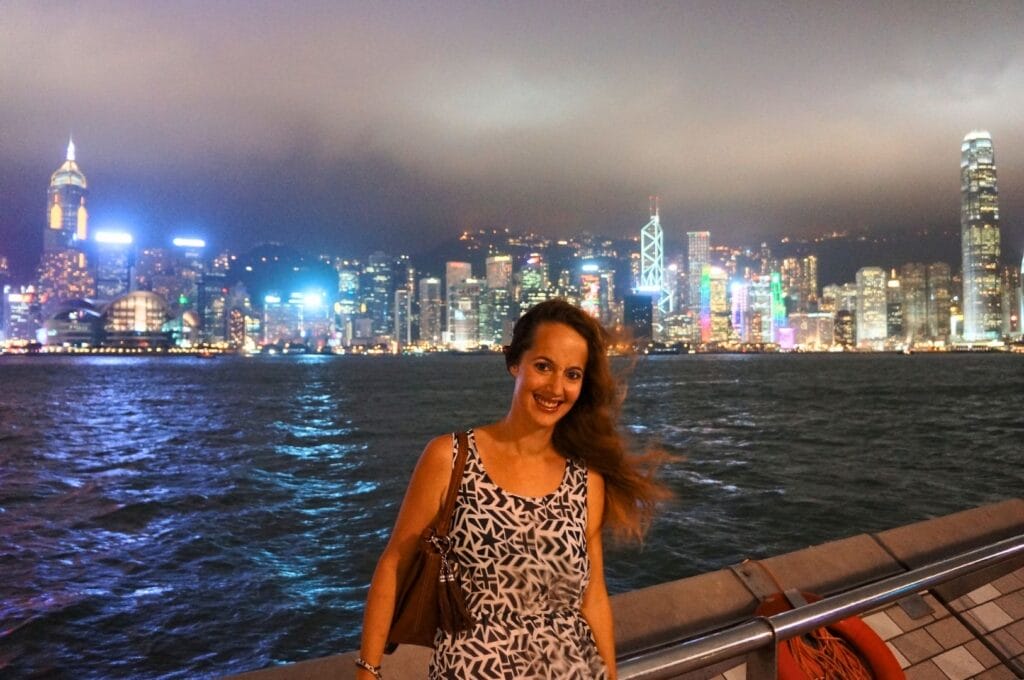
Kowloon
The Kowloon Peninsula is a concentration of both authenticity and modernity.
Mong Kok attracts both locals and travelers. This popular neighborhood is centered around Nathan Road, the long main road that leads to the waterfront. Walking around, you’ll understand why Hong Kong has one of the highest population densities in the world ;). You’ll mainly find markets to wander through day and night.
Tsim Sha Tsui (called TST) is Kowloon’s most vibrant neighborhood. Its waterfront is a must-see just for the magnificent view of the skyline. It’s also a must for travelers as this is where you’ll find plenty of museums, shopping centers, luxury hotels, the Avenue of Stars…
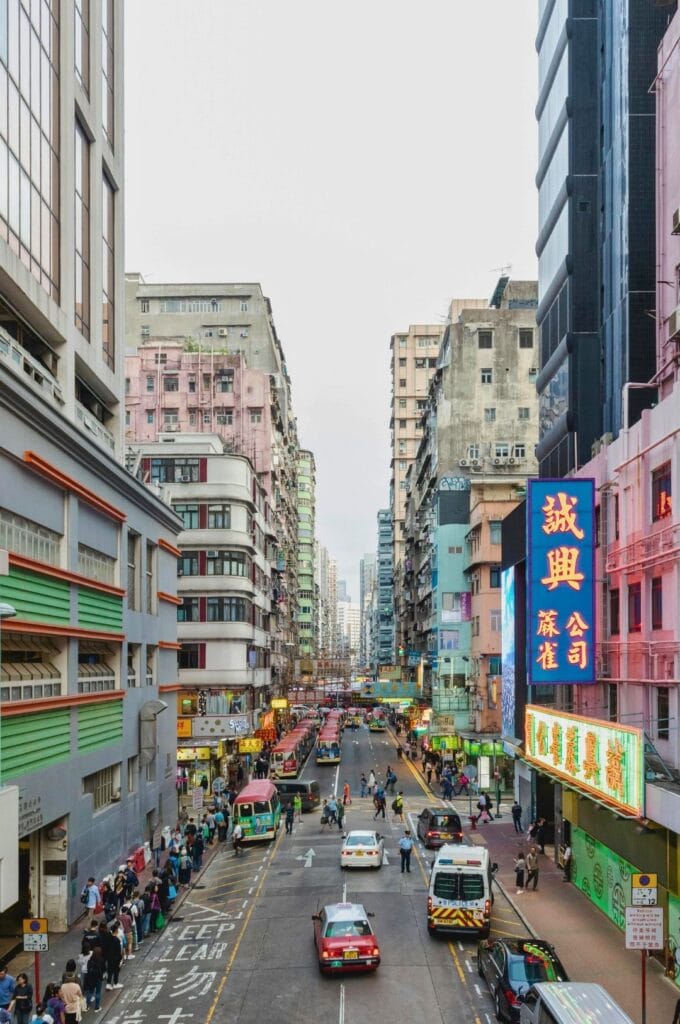
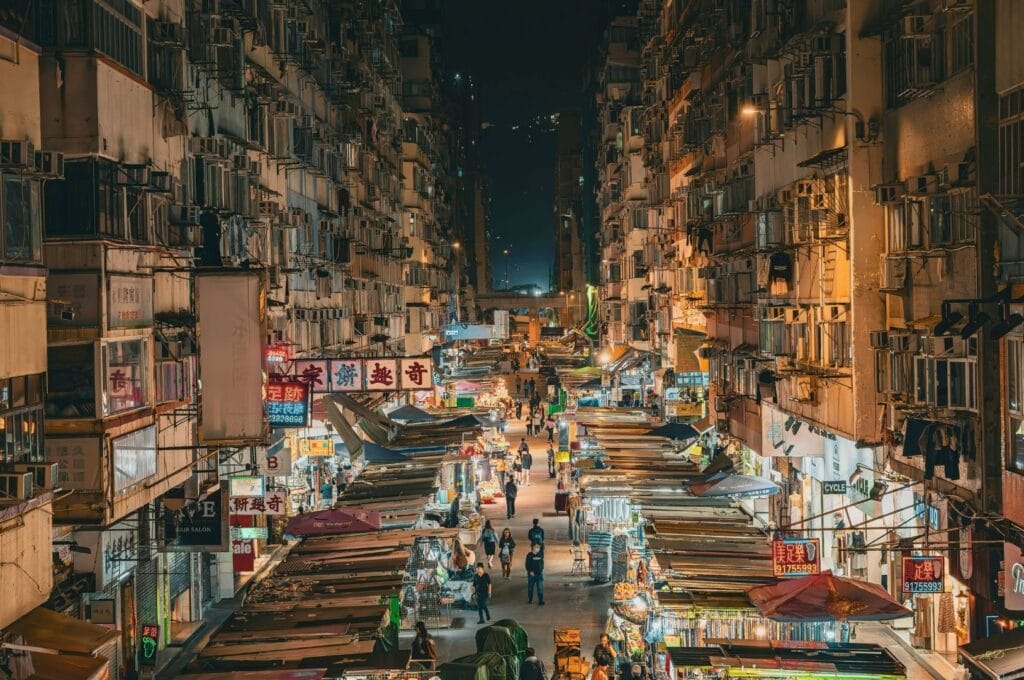
Hong Kong Island
Central is the business district with its skyscrapers housing the headquarters of the largest banking companies. But this neighborhood also hides a historic part, Old Town Central, toward Sheung Wan, the neighboring district. This is also where you’ll take the Mid-Levels Escalator, the longest outdoor escalator in the world!
Sheung Wan is one of Hong Kong’s oldest neighborhoods. It’s seen as a bridge between modernity and tradition. Here, old Chinese shops and temples sit alongside trendy cafes and stores.
Just to the east, Causeway Bay is the more commercial district with its huge malls. It’s the temple of shopping (or temptations ;)). Right next door, in Happy Valley, nestles the racecourse, an essential place to spend your Wednesday evening!


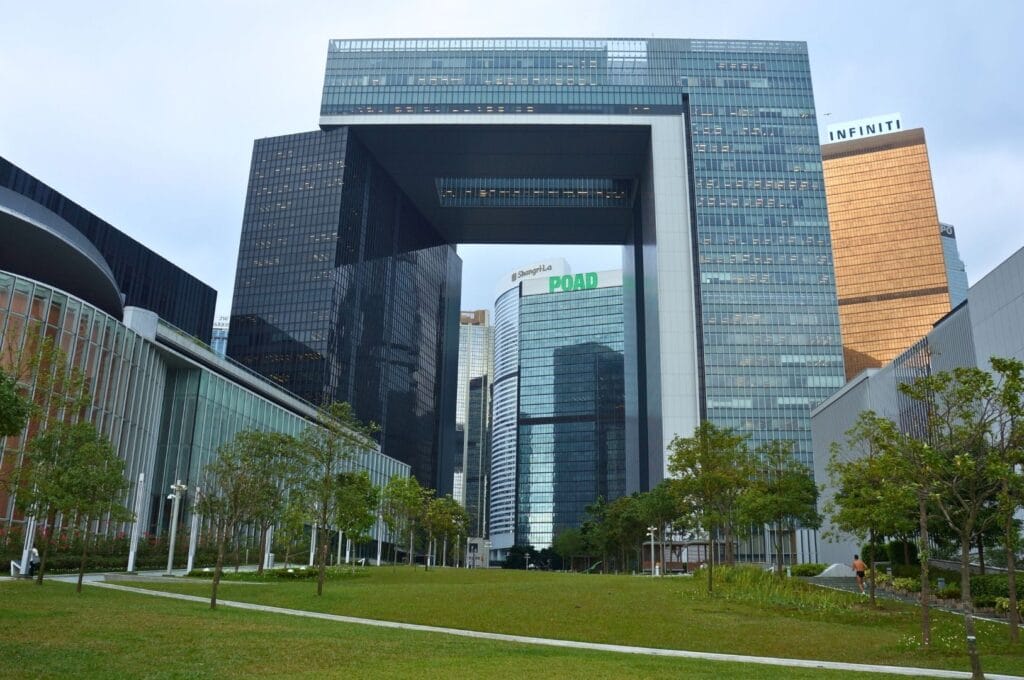
The Peak neighborhood is located in the center and west of the island and spreads around Victoria Peak, the highest point on Hong Kong Island. Numerous hiking trails wind through the different parks, perfect for finding some nature in this urban fervor!
Finally, the south of the island is reserved for nature lovers, quieter spaces, and also theme parks! Head out on the Dragon’s Back trail, relax on Repulse Bay beach, or have fun at Ocean Park amusement park or Water World water park.
New Territories
Basically, the New Territories encompass everything else! This includes the area between the Chinese border and Kowloon (Sai Kung East Country Park, Ten Thousand Buddhas Monastery), Lantau Island (Disneyland, the international airport, the Giant Buddha…), and all the small islands in the bay. To access the latter, the ferry is a must, but there’s enough to spend several days there! We recommend visiting Cheung Chau Island or Peng Chau Island to discover a very different side of Hong Kong.
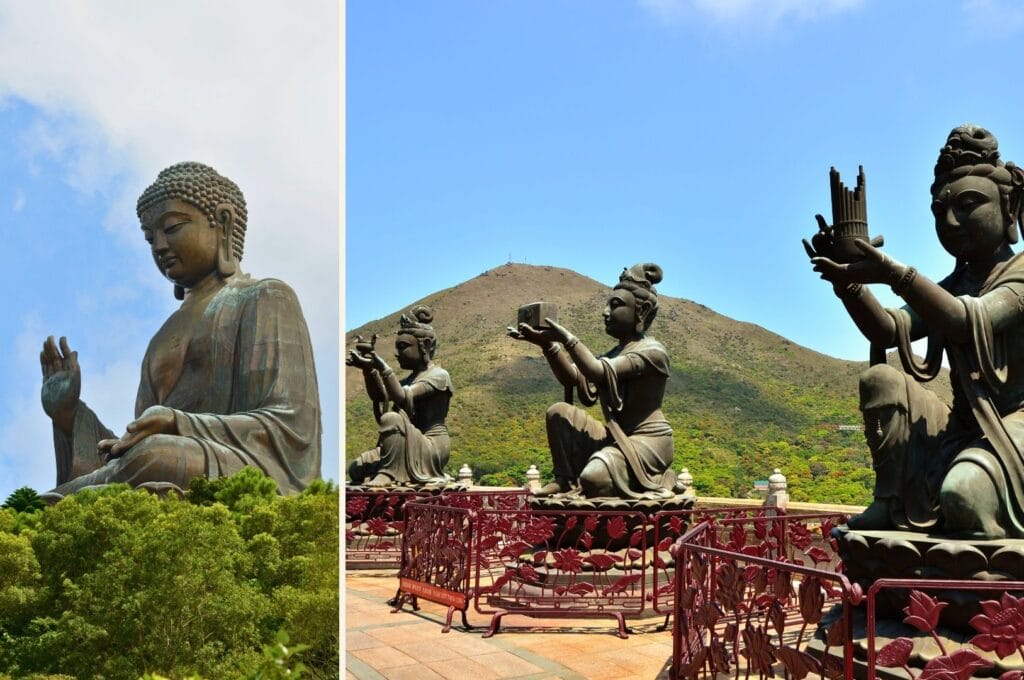

Climate: what’s the best time to visit Hong Kong?
It’s simple: in Hong Kong, it’s hot and humid year-round due to the subtropical climate. Average temperatures range between 15 and 30°C. And this intensifies in summer, between May and September, with the monsoons. Also, typhoons are not uncommon… In winter, it’s a bit cooler (meaning a minimum of 19°C) and precipitation is lower. To visit the city in good conditions, go between October and April! We were there in November and the weather and temperatures were perfect.
How to get to Hong Kong?
By plane
Hong Kong International Airport is located on Lantau Island and receives flights from around the world. As it’s a hub, many travelers make a quick stopover before heading to their final destination. Whether you’re already in China or coming from Europe, you’ll definitely have a direct flight.
For a Paris–Hong Kong flight, expect 530 euros round trip with a stopover and 900 euros for a 12-hour direct flight. For a Beijing–Hong Kong flight, the plane ticket costs just under 100 euros per person for a 4-hour flight. Finally, if you’re in Thailand, a Bangkok–Hong Kong flight will cost you about 70 euros for a 3-hour flight.
How to get to the city center from the airport
The fastest way to reach the city center from the international airport is to take the MTR Express. This shuttle takes you to the heart of Hong Kong in 30 minutes. The ticket costs about 17 dollars per person (132 HKD) for a one-way trip to Hong Kong Station, Kowloon Station, Tsing Yi Station, and 29 dollars for the round trip (147 HKD). If you don’t have your Octopus card yet, book your ticket online for peace of mind.
Otherwise, the bus is an alternative means of transport, but the journey takes 1 hour… To go to Hong Kong Island, take line A11 (Sheung Wan, Central) or A12 (Chai Wan, east of the island). If you’re going directly to Kowloon, it’s line A21 that will take you to Mong Kok or Tsim Sha Tsui. (Lines A22 and A29 go to the north of the peninsula.) Depending on your destination, expect to pay between 35 and 45 HKD for your ticket. Does your flight arrive at night? Look for bus lines with an “N” in front of the number.
Tip: You can pay for your bus ticket in cash, directly with your Octopus card (we’ll talk about it just below), or with your foreign credit card.
By train
Already in China? All Chinese trains serve Hong Kong, but are you ready to travel in slow mode? The high-speed train between Beijing and Hong Kong takes 8 hours for a ticket that costs 150 euros. If you’re coming from Canton (Guangzhou) like us, the train journey takes 1 hour for a price of about 30 euros. In short, we chose to travel around China by bus and train and it works very well ;).
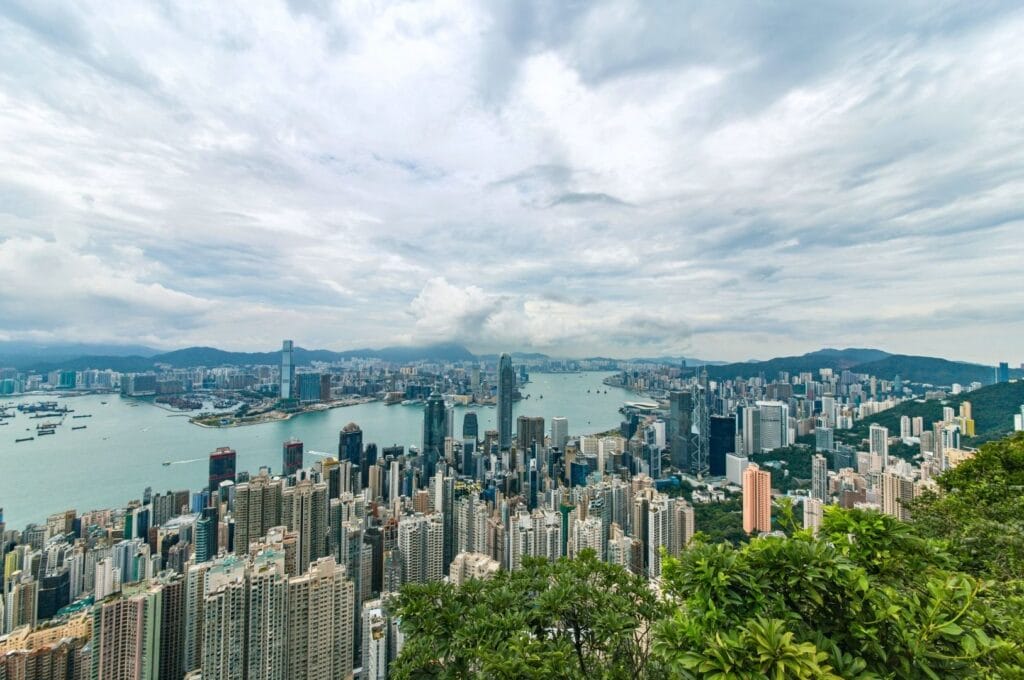
This article contains affiliate links to partner sites. When you use our links to book accommodation, a car, or an activity, you don’t pay anything extra, but we get a small commission. This helps us to offer you free, independent, and ad-free content. Thank you for your support!
Getting around the city
Since Hong Kong is quite spread out, the metropolis is extremely well served by public transport. Bus, metro, tram, ferry… You’re spoiled for choice! But before any trip, get yourself an Octopus Card. This card allows you to pay for everything: transport, shopping, restaurants, activities… It costs 39 Hong Kong dollars, or 4.3 euros. You can get it and recharge it with your bank card everywhere: 7-Eleven, Circle K, at the airport, in any MTR station, etc. If there’s money left on it at the end of your stay, go to a point of sale to recover the balance. There’s also an Octobus app, but it seems it’s not optimal and often bugs…
For more information on the other functions of this card, we detail everything in the section dedicated to money and budget.
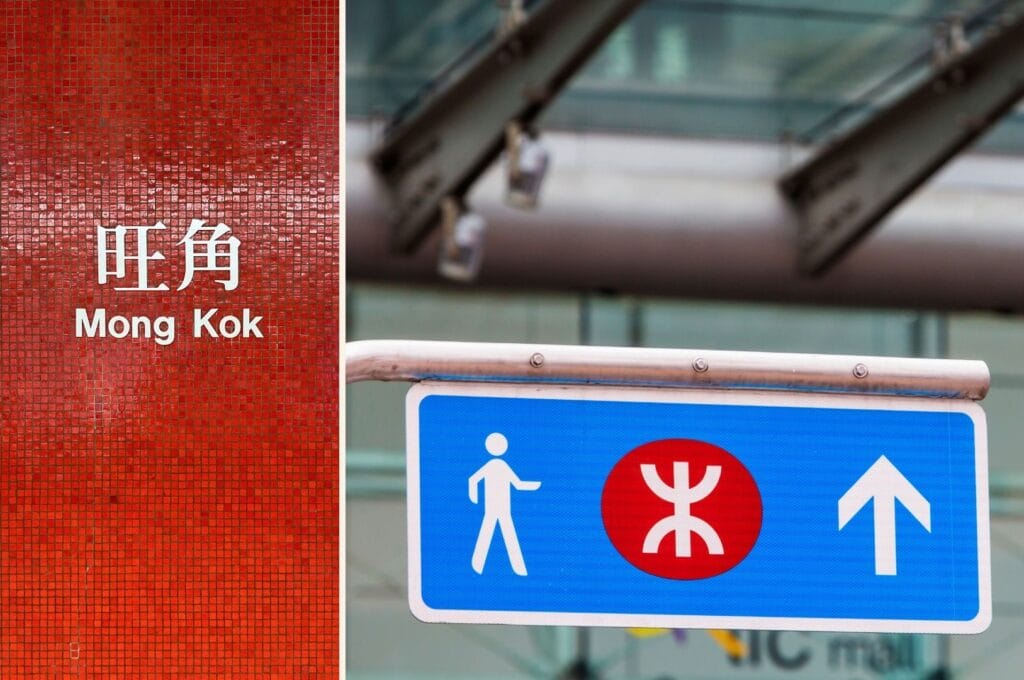
By metro
Hong Kong’s subway is called the MTR and covers the city well. Modern, punctual, and frequent, it will be your best ally for visiting almost everything! Everything is written in Cantonese and English, impossible to go wrong! A subway ticket costs between 6 and 32 HKD (between 0.66 and 3.55 euros), depending on your starting station and destination. In any case, always use your Octopus card by scanning it at the metro entrance rather than buying a single ticket for each journey.
Here’s the map of the Hong Kong metro network, click on it to download it. It will help you find your way among all the stations. If you’re completely lost, the planner and Google Maps will be very useful!

By tram
The double-decker tram has been an institution on Hong Kong Island since 1904! Nicknamed “ding ding”, these 165 decidedly vintage-style trams will take you between the east and west of the north of the island. We recommend taking it at least once just for the experience. At the ticket price (3.3 HKD, or 0.3 euro), it would be a shame to miss out! To go further, you can board the TramOramic, an old-style tram with an open upper deck that offers a specific 1-hour route with an audio guide. This special ticket (Golden Ticket) costs 220 HKD (25 euros) and also includes free access to the tram network for 2 days.
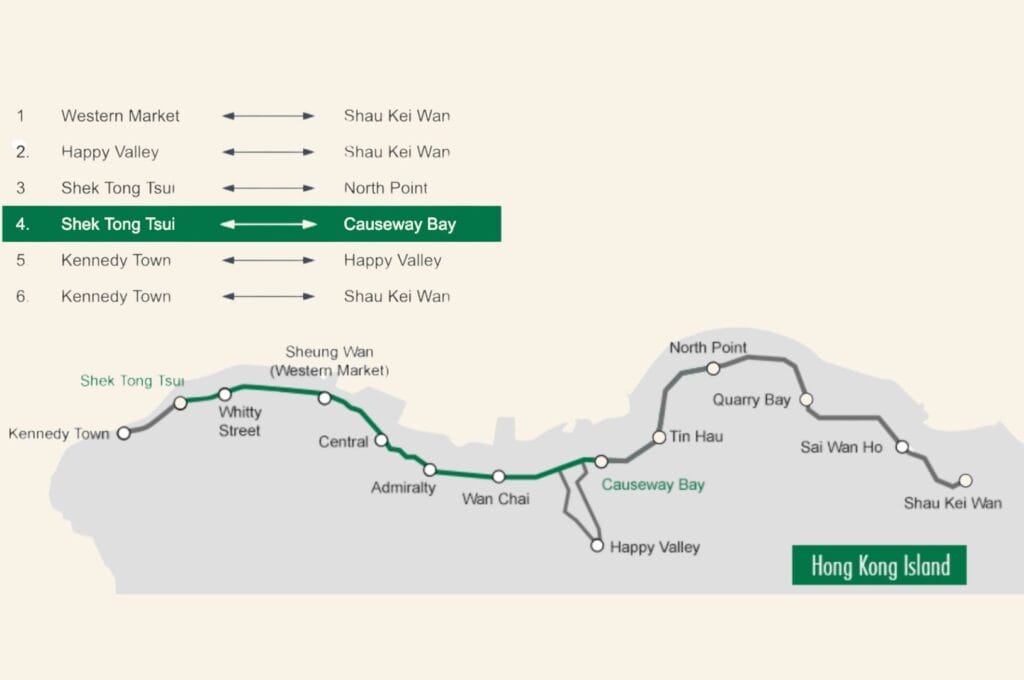
By bus
The bus can be convenient for getting from one end to the other, but we prefer the tram – at least you avoid traffic jams! However, like all big cities, Hong Kong has its own Hop-On Hop-Off bus, the Big Bus. 3 lines cross the metropolis: the blue line for Kowloon, the red line for the north of Hong Kong Island, and the green line for Stanley, in the south of Hong Kong Island. Choose a 1-line ticket or a ticket to do all 3 and you get on/off as you please. The standard ticket (1 line + 1 ferry ride) costs 412 HKD, while the ticket that covers all lines (+ return ferry) costs 567 HKD.
By ferry
Hong Kong’s ferry (Star Ferry) is iconic! You’ll probably take it at least once to cross Victoria Harbour to reach Hong Kong Island. Boats depart from Tsim Sha Tsui port in Kowloon to the ports of Central and Wan Chai on the island. You have departures about every 10 minutes. The Star Ferry from Central runs between 6:30 am and 11:30 pm, and the Star Ferry from Wan Chai runs from 7:30 a.m. to 11 p.m. An adult ticket costs between 4 and 6.5 HKD (between 0.4 and 0.7 euro!).
This will also be your means of transport to reach the more isolated islands in Hong Kong Bay (Cheung Chau, Peng Chau, Lamma…).
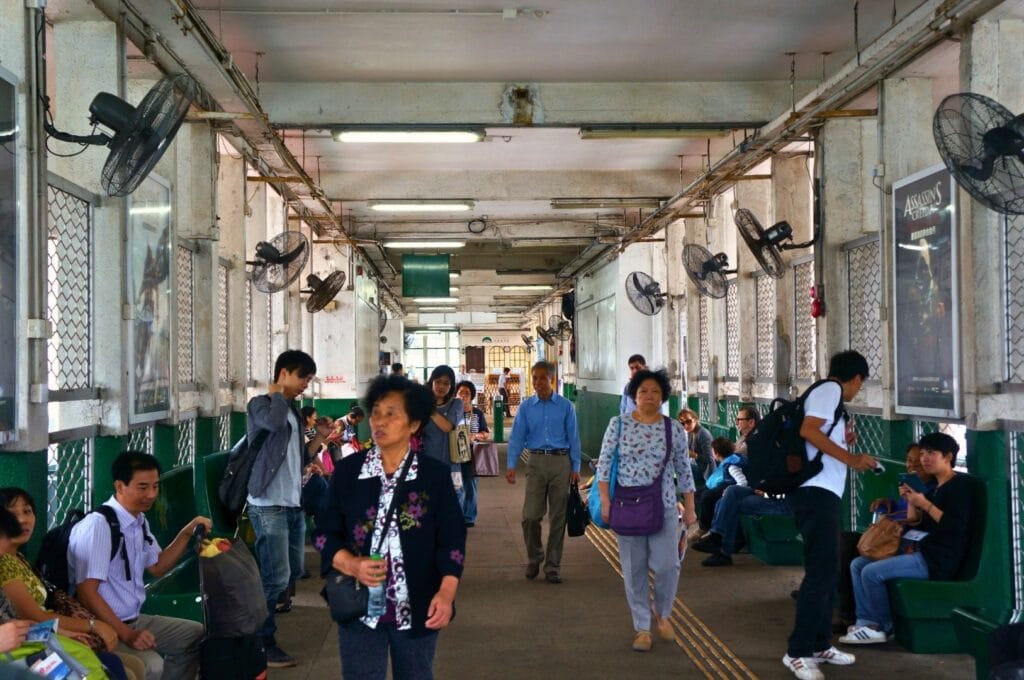

By taxi
We’ve deliberately placed taxis in last place. Public transport is so well developed and affordable that taking a taxi isn’t worth it! If you have no choice but to take a taxi, make sure the driver activates his meter! In the Kowloon Peninsula, official taxis are red.
Where to stay
Backpacker budget
We’ve already mentioned it, Chungking Mansion is the meeting place for backpackers stranded in Hong Kong who don’t have millions to spend. Located in the Tsim Sha Tsui waterfront district in Kowloon, this rather gloomy large building houses more than 25 different guesthouses on nearly 20 floors. The experience isn’t incredible, but it’s a good address for cheap accommodation in the city of luxury. Among all the establishments, we recommend Just Inn on Nathan Road. It’s clean, well-maintained, and you won’t have any bad surprises. Outside Chungking Mansion, Hop Inn works well for a night in a dorm, as does Pillows CoLiving for a double room.
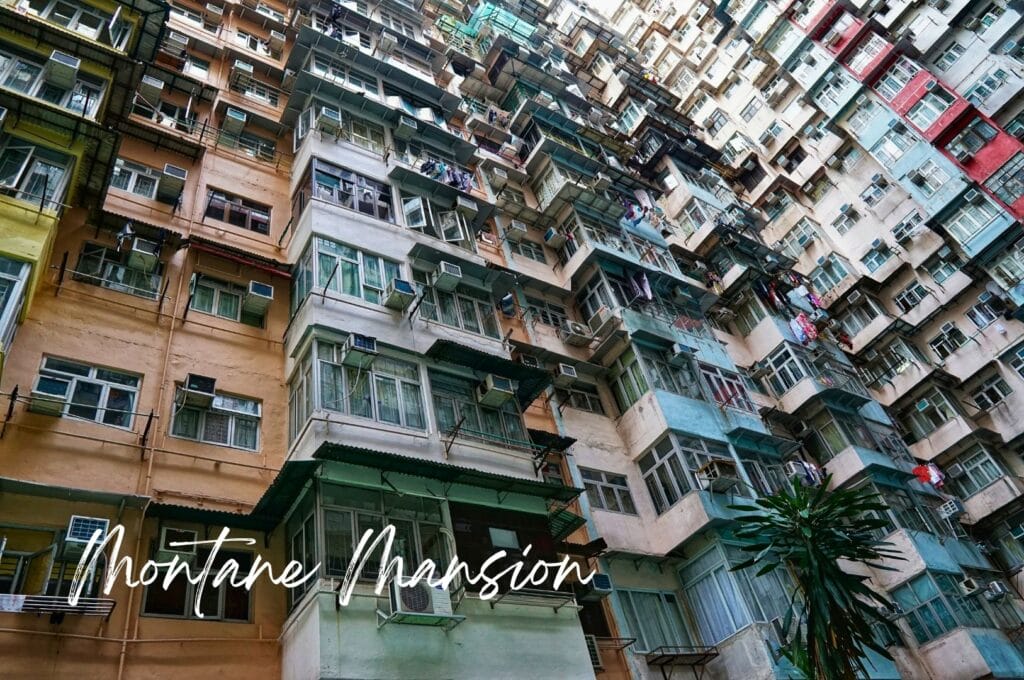
If you’re thinking of staying on Hong Kong Island, we recommend the HI hostel for its location in Causeway Bay and its value for money. Finally, on Lantau Island, the choice remains limited for budget travelers… Most accommodations are located near the airport and on the coast. Therefore, we recommend sleeping in Kowloon or on Hong Kong Island, even to visit Lantau (with the metro, it’s quick).
Otherwise, a bed in a dorm in a good hostel costs about 25 euros per person. For a double bed in a good establishment (meaning with good value for money), expect 50 euros per night. When we told you Hong Kong has nothing to do with mainland China ;).
To compare room rates, visit Booking or use the map below.
Mid-range budget
Here, we’re talking more about 150-200 euros per night for a double room with a private bathroom.
In Kowloon, the Mondrian hotel promises an incredible view of the bay from its modern rooms. On Hong Kong Island, this beautifully decorated all-comfort studio is very well located: a real cocoon without breaking your budget!
High budget
Want to treat yourself after being careful during your trip to China or in the middle of your world tour? Hong Kong is full of high-end establishments. The most prestigious remain the Rosewood in Kowloon and the Four Seasons on Hong Kong Island for a luxury experience.
What to do in Hong Kong in 4 days: must-see itinerary
The metropolis has a lot to offer, whether you’re more into shopping, nature, culture, or gastronomy. We bet you’ll be fascinated by its blend of East and West, modernity and tradition! With this itinerary, you’ll get a great overview of the best of Hong Kong. During your stay, we recommend focusing on one area each day. For example, spend days 1 and 2 on the Kowloon Peninsula, day 3 on Hong Kong Island, and day 4 on Lantau Island. We’ve established a kind of visit plan with the list of must-sees below. Follow the guide and add stops if you’re staying more than 4 days!
Day 1: in the heart of Kowloon, between temples and markets
For this first day in Hong Kong, focus on Kowloon. Take the pulse of all the hustle and bustle that animates the city.
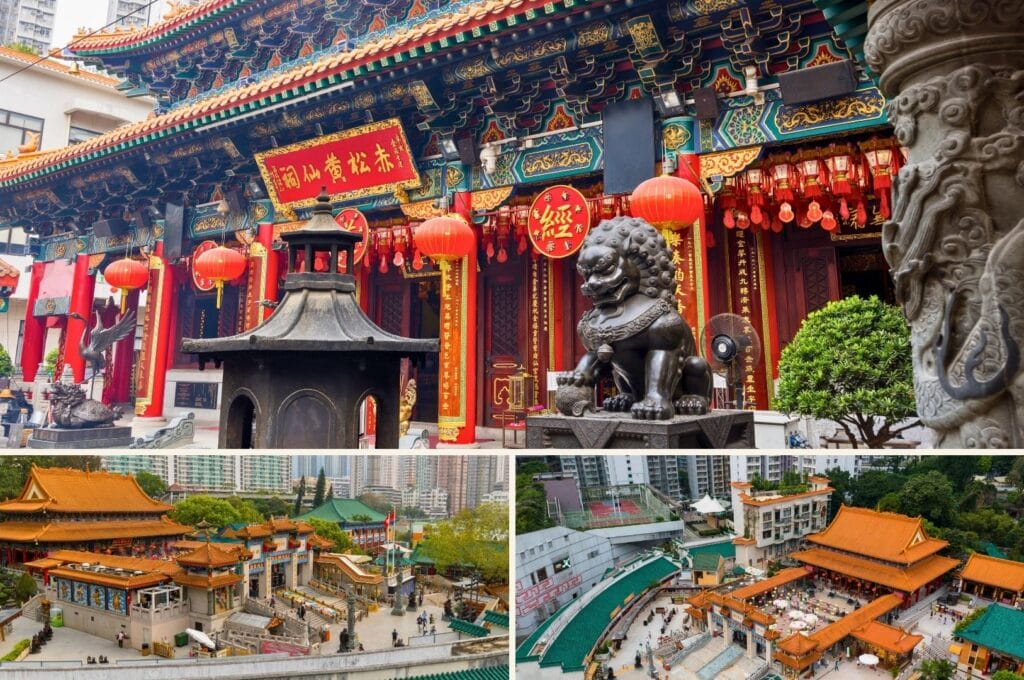
Visit Wong Tai Sin Temple and Good Wish gardens
Then head to the Wong Tai Sin district to visit the Sik Sik Yuen Wong Tai Sin Temple. Its particularity? This magnificent historic Taoist temple is located in the heart of a complex dedicated to religion and spirituality. Its colors and architecture contrast with the surrounding tall buildings. Built according to feng shui principles around the 5 elements (water, fire, wood, metal, and earth), it’s also a place dedicated to prayer and divination, particularly the kau cim ritual. The principle? You shake a bamboo cylinder containing numbered sticks, thinking about your question/problem. The stick that falls is then picked up and given to a fortune teller who will interpret the answer.
Practical information: The site is open daily from 7:30 a.m. to 5:30 p.m. Admission is free. The nearest MTR station is Wong Tai Sin. Allow 25 minutes by metro from the waterfront.
Walk through Nan Lian gardens and visit Chi Lin nunnery
Not far from there, walk through the peaceful alleys of Nan Lian gardens and Chi Lin nunnery. Probably one of Hong Kong’s most beautiful green spaces, the park is the perfect place to take your time. Built in the style of the Tang Dynasty, the site offers a subtle balance between nature and architecture. The place is superbly maintained and it’s great to stroll around. Fun fact: the nunnery was built without using a single nail!
Practical information: The gardens are open daily from 7 a.m. to 9 p.m. From Wong Tai Sin Temple, you can walk (about 20 min walk) or take the metro and exit at Diamond Hill station.
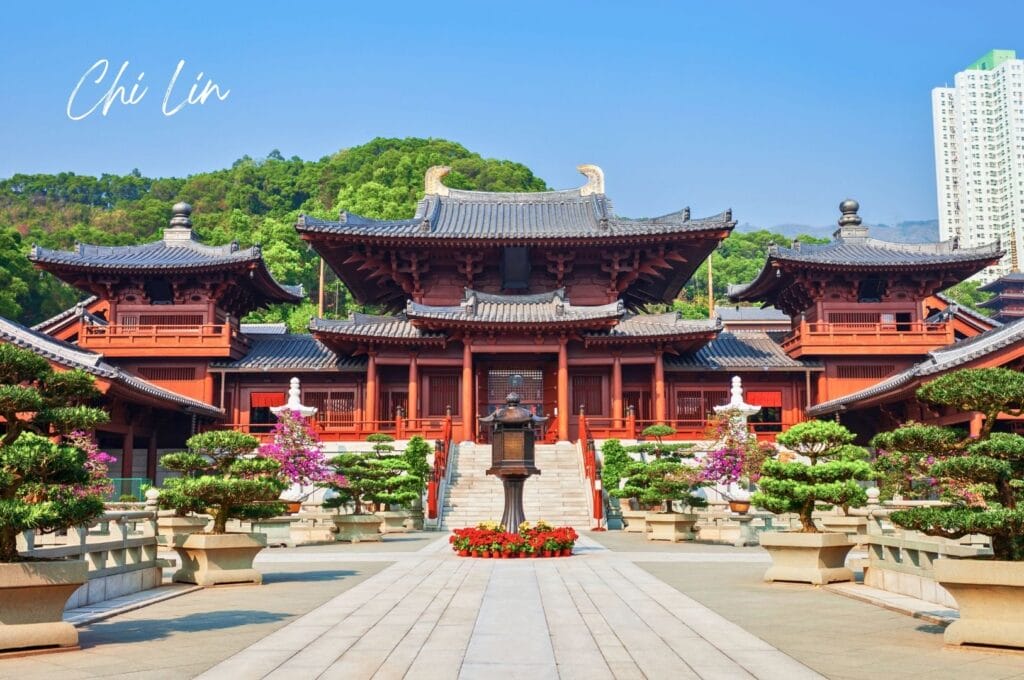
Live like Hong Kongers in Sham Shui Po
Sham Shui Po is a working-class neighborhood in western Kowloon that’s worth the detour. We’re far from the tourist hustle and bustle of Mong Kok! Here, you’ll discover a piece of local history and a popular neighborhood with its authentic canteens. In the 1950s, families were crammed into tiny dwellings that ended up being destroyed by fire, then rebuilt as public housing. To learn more about Sham Shui Po, the housing crisis, and Hong Kong’s darker side with cage apartments, this guided tour is made for you.
In any case, it’s the perfect place to eat lunch, whether at the markets or at the famous Tim Ho Wan, a restaurant specializing in dim sum (it even got a star in the Michelin guide!).

Among the curiosities of this expanding neighborhood, there’s the Golden Computer Center and Arcade, a huge store for video game, computer, and electronics fans. If you have kids or are still a big kid yourself, then Toy Street on Fuk Wing Street is for you! There, toys from all eras are ready to be adopted! It’s also here that locals come to buy their decorations for different national/religious holidays. After Toy Street, here’s Bead Street on Yu Chau Street, parallel to Fuk Wing. You’ll find all kinds of beads and sewing accessories.
Practical information: Get off at Sham Shui Po metro station, 10 minutes from the waterfront.
Discover the Mong Kok markets
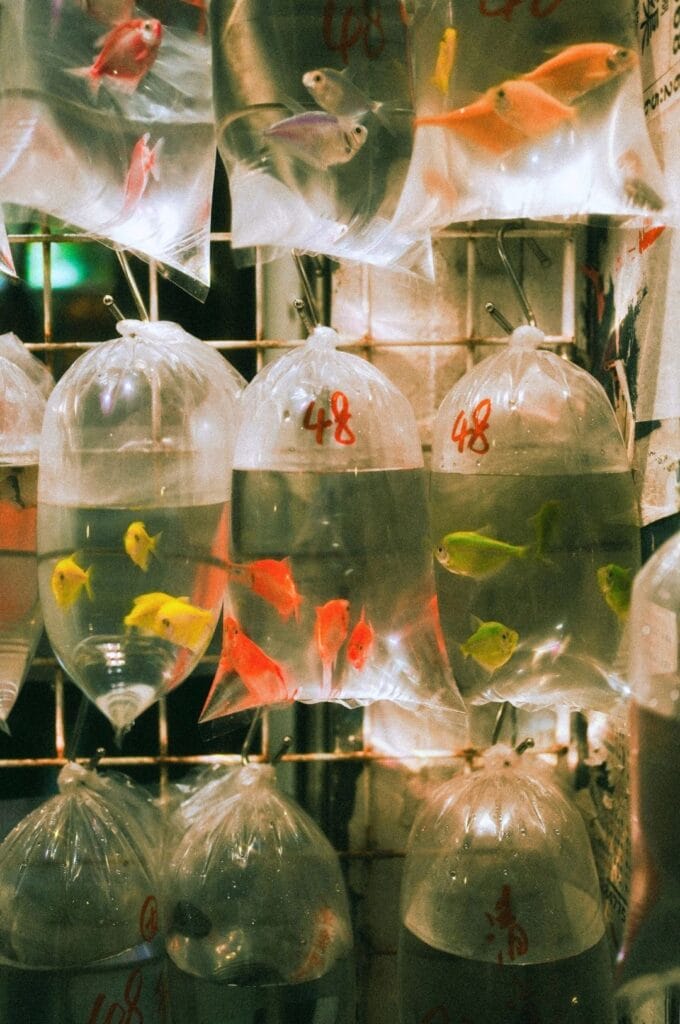
In the early afternoon, stroll through the different markets in the vibrant Mong Kok neighborhood. You should know that you can easily find “specialized” markets in Hong Kong: fish market, bird market, jade market…
Head to Prince Edward’s flower market with its flowers of all kinds! It’s open daily from 9:30 a.m. to 7:30 p.m. Further along Flower Market Road is the bird market. It might be worth a look for the different bird species but nothing more… Seeing birds crammed in cages isn’t what I prefer most. A little further south, there’s the fish market and it’s the same principle as the bird market: (aquatic but not only) animals locked up waiting to be sold. The nearest metro station is Prince Edward.
The Ladies’ Market is a shopping hotspot not reserved only for women (quite a shortcut if you ask me). You’ll find absolutely everything in this maze of stalls. We recommend going there just once, just out of curiosity or if you have something to buy. It’s open daily from 11 a.m. to 11:30 p.m. The nearest MTR station is Mong Kok.
Tip: Whatever you buy in the markets, negotiate!
Spend the evening at Temple Street market
To finish the day beautifully, head to Temple Street night market! This market showcases street food in small stalls (dai pai dongs) and shopping; the atmosphere is unique. You’ll find absolutely everything there, you can even ask a fortune teller about your future! It’s open daily from 5 pm to midnight, and to get there, get off at Jordan MTR station.
Only staying 1 or 2 days in Hong Kong? In that case, we’d recommend doing this guided city tour instead. You’ll see the must-sees and understand Hong Kong better thanks to the guide’s explanations.
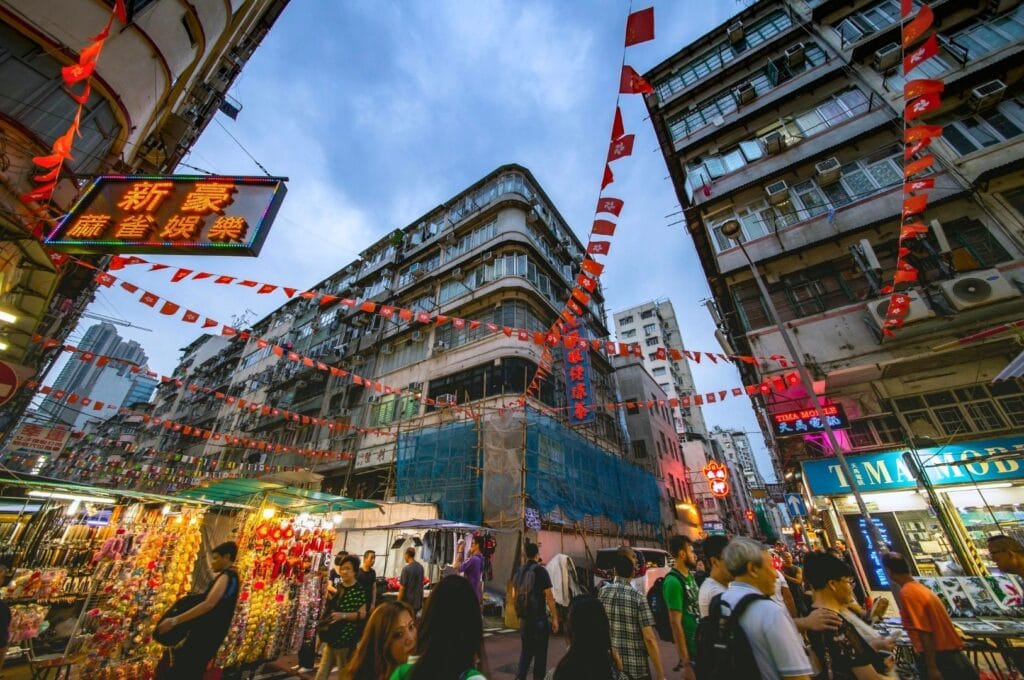
Day 2 in the New Territories and Tsim Sha Tsui
Visit the Ten Thousand Buddhas Monastery
The Ten Thousand Buddhas Monastery is worth the effort! A word of advice: leave early to enjoy the site when temperatures are a bit cooler ;). The reason? Simply 430 steps to climb to the top, where you’ll have a lovely panorama!
No fewer than 12,000 different golden Buddha statues are positioned on either side of the steps and scattered throughout the site. Here, you take the time to walk while observing the differences between the statues, to contemplate the colorful temples and pagodas at the summit. In short, it’s a unique, peaceful place, somewhat overlooked by tourists.
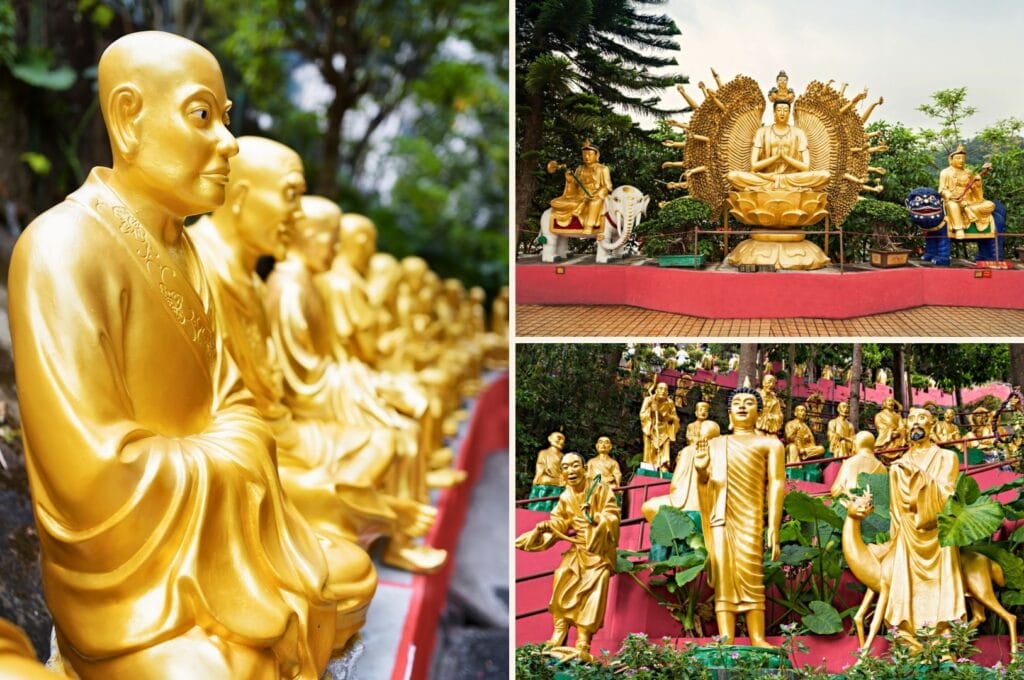
Note: Although it has the denomination of a monastery, it’s more of a temple complex since no monks live here. Be careful of fake monks who will ask you for money.
Practical information: The monastery is located in Sha Tin village, 30 minutes by MTR from Tsim Sha Tsui (get off at Sha Tin station). The visit is free :).
Visit the Hong Kong Heritage Museum
You’ll see there are many museums in Hong Kong, some are definitely worth seeing! This is the case with the Hong Kong Heritage Museum, which traces the city’s history, as well as its artistic and cultural heritage through magnificent exhibitions. After this visit, Hong Kong culture (and Bruce Lee) will have no secrets from you. Plus, it’s free, what more could you ask for!
Practical information: The museum is located in Sha Tin village, 30 minutes by MTR from Tsim Sha Tsui. Get off at Sha Tin station and walk 10 minutes. Opening hours: every day except Tuesday from 10 am to 6 pm (closes at 7 pm on Saturday and Sunday).
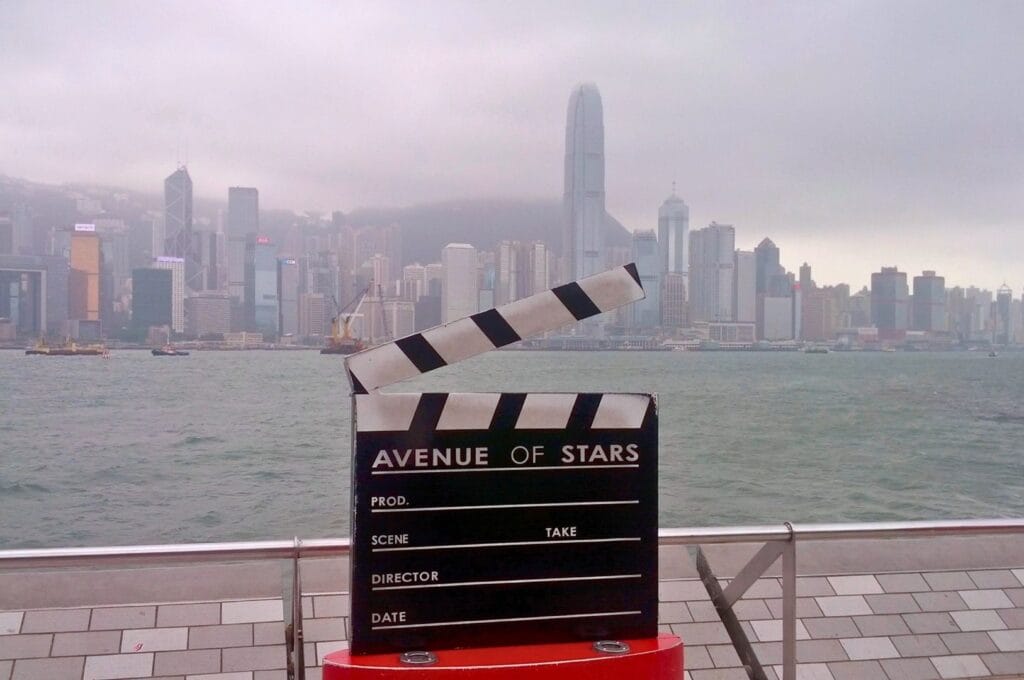
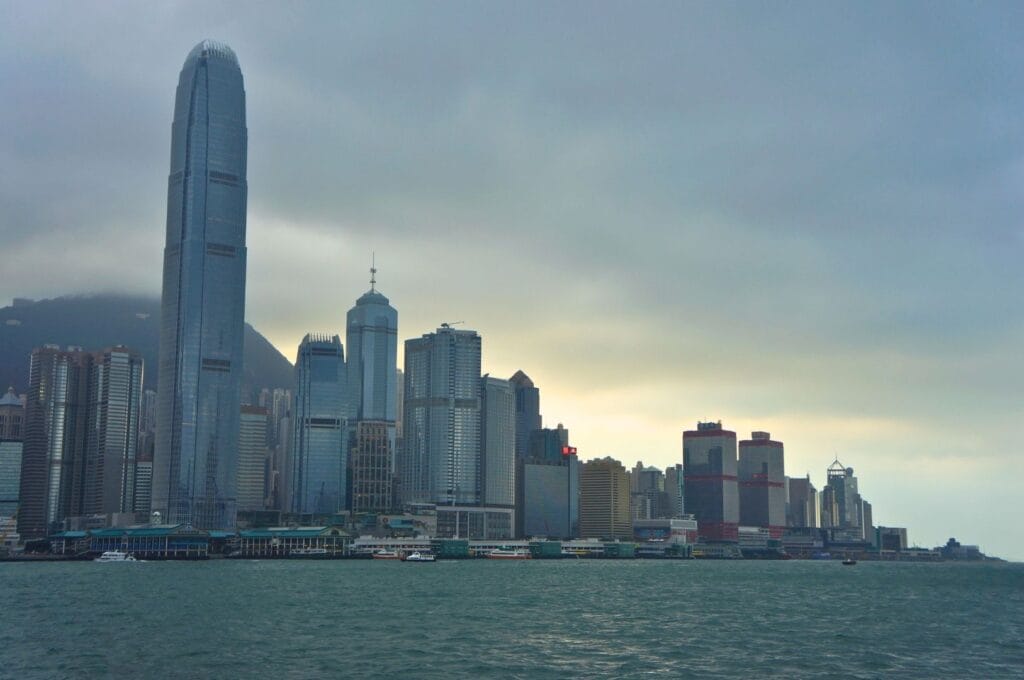
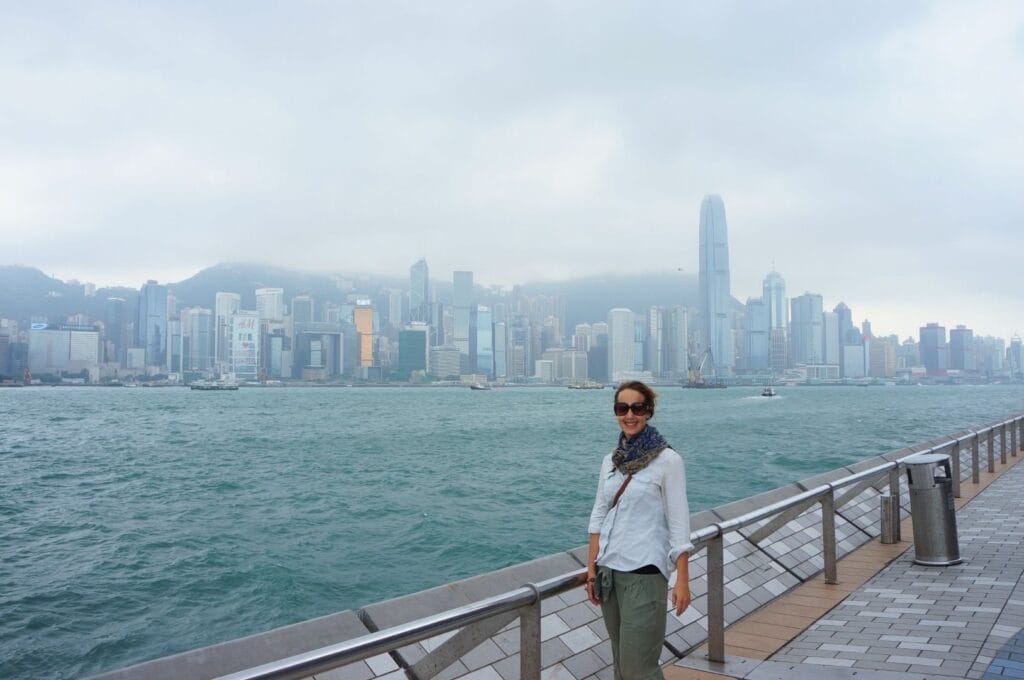
Walk along the Tsim Sha Tsui waterfront
To continue and finish this first day, return to Kowloon to go to the Tsim Sha Tsui waterfront. From the eponymous MTR station, walk 50 meters east to enter K11 Art Mall. As its name suggests, this shopping center combines trendy boutiques, art exhibitions, and regular events. At least pass through the atrium for its amazing design!
Then walk up Nathan Road, the artery of the Kowloon Peninsula. You’ll pass by Chungking Mansion, which we mentioned in accommodations. You’ll arrive at the waterfront with a very nice view of Victoria Harbour, Hong Kong’s skyline, and the mountain peaks! Stroll along the Avenue of Stars, Hong Kong’s equivalent of The Walk of Fame with all the local celebrities, and walk along the harbor passing by the Bruce Lee statue. On the other side, at the harbor level, you’ll see the Clock Tower, a historic monument and vestige of the old Kowloon station built in the early 20th century. We walked there both day and night and the city takes on a completely different look once the sun sets!

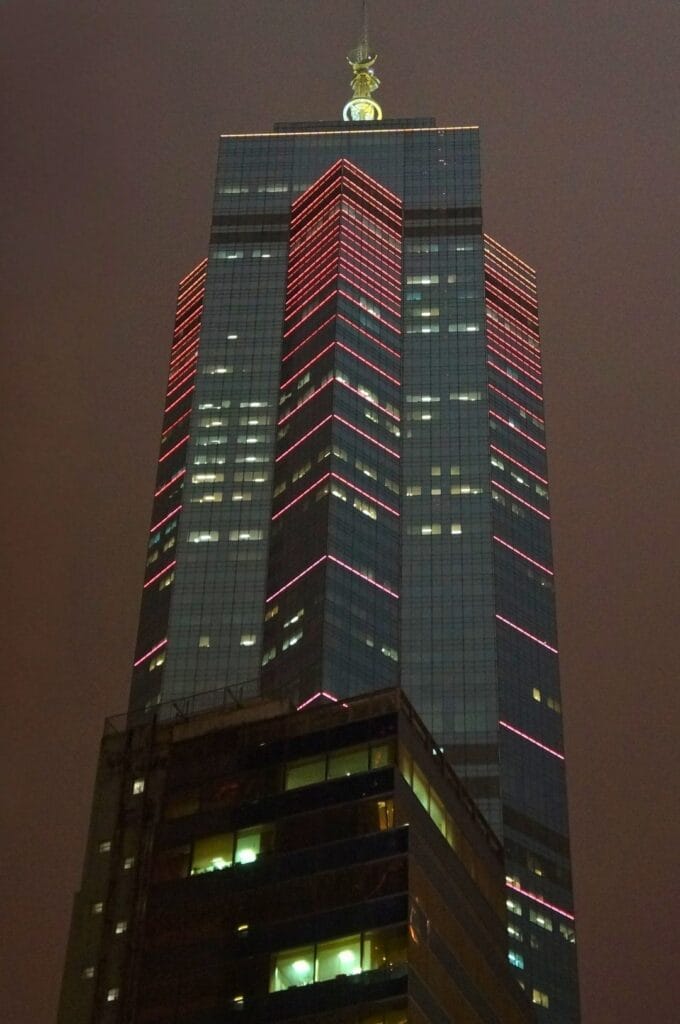
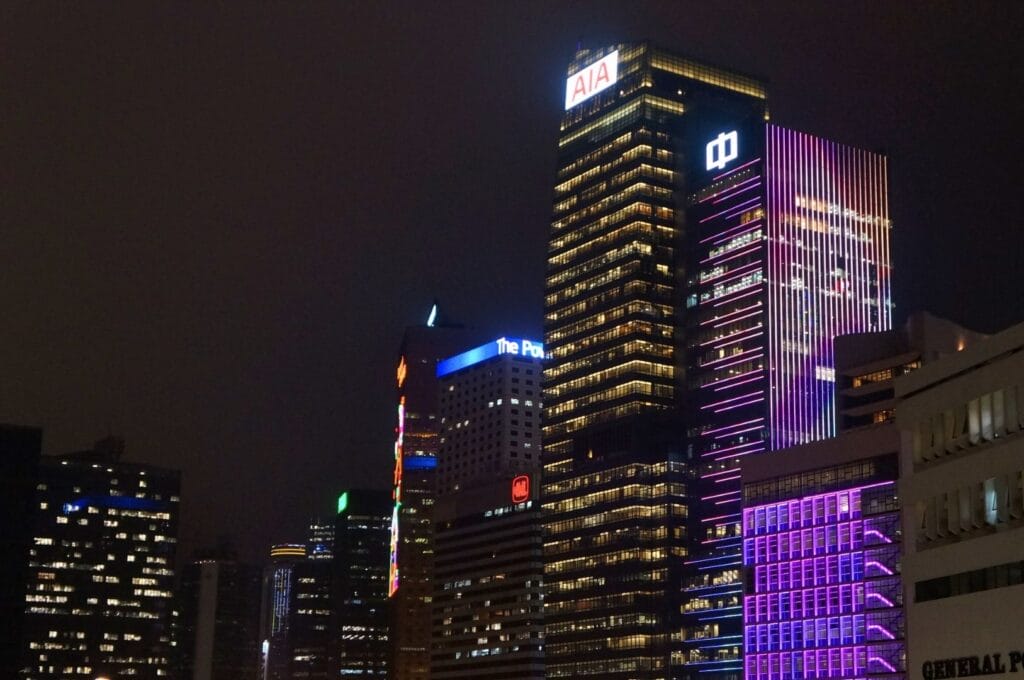
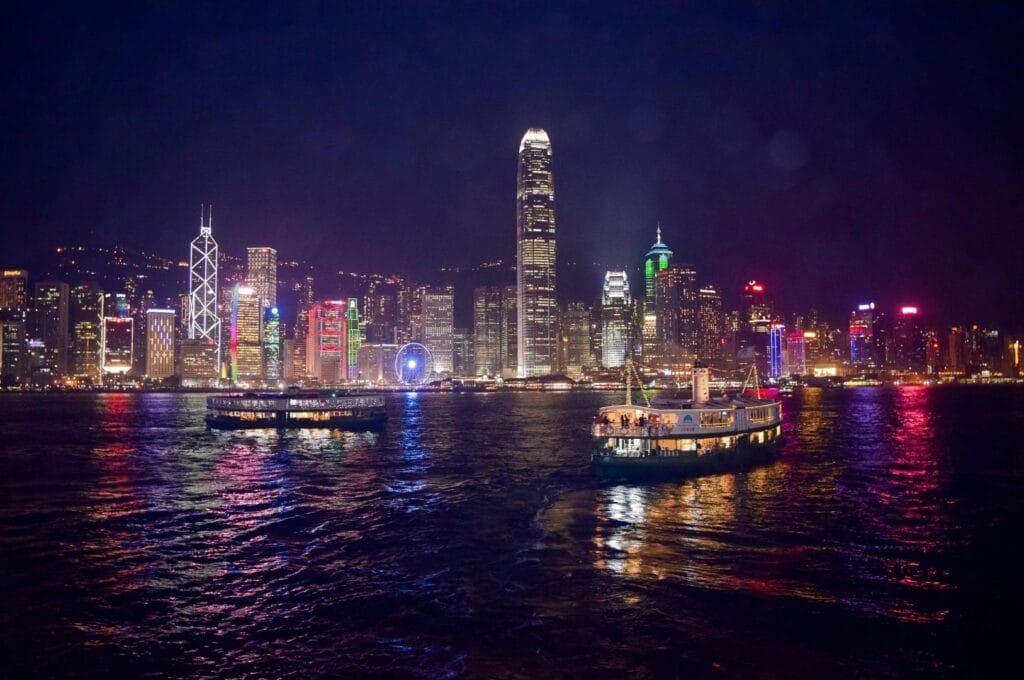
Watch A Symphony of Lights show
If there’s one free show not to miss, it’s A Symphony of Lights. Projected onto several dozen buildings from the Tsim Sha Tsui promenade, this sound and light show is truly magnificent. And it’s free! Head to the waterfront at 7:30 p.m. for 10 minutes of the show. Even though it starts at 8 p.m., arrive early because it’ll be crowded!
Another way to watch this show is to board Hong Kong’s oldest Chinese boat for a night cruise on Victoria Harbour. Find all the information online.
Day 3: Visit Hong Kong Island
Take the Star Ferry to cross the bay
If you skip the Star Ferry, we won’t say you ruined your trip, but close ;). Another symbol of Hong Kong, the Star Ferry, was inaugurated in 1888 and its green and white boats have become iconic. The crossing between Kowloon port and the Central or Wan Chai districts takes 10 minutes and the fare is 4-6.5 HKD depending on your destination and day of the week.
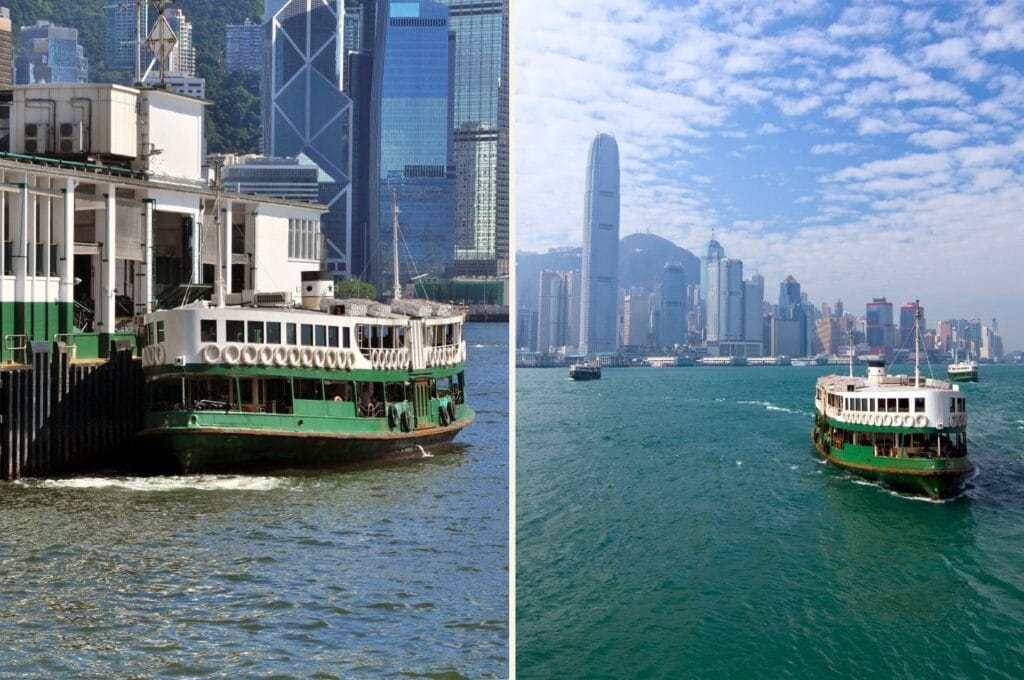
Discover Central and the historic district
Central is Hong Kong’s business district with its skyscrapers that form the famous skyline. It’s also here that we discovered the famous Central-Mid-Levels Escalators, the largest outdoor moving walkway system in the world! At 800 meters long, you’ll reach the upper part of Central while gaining 130 meters in elevation. Its particularity? It goes up or down depending on the time of day! Basically, you go down from 6 a.m. to 10 a.m. and up from 10 a.m. to midnight.
It’s also in Central that you’ll discover the city’s oldest neighborhood, Old Town Central, at the junction of Sheung Wan district. Resolutely dynamic and artistic, where numerous murals coexist with independent shops and historic buildings, it’s great to wander around!

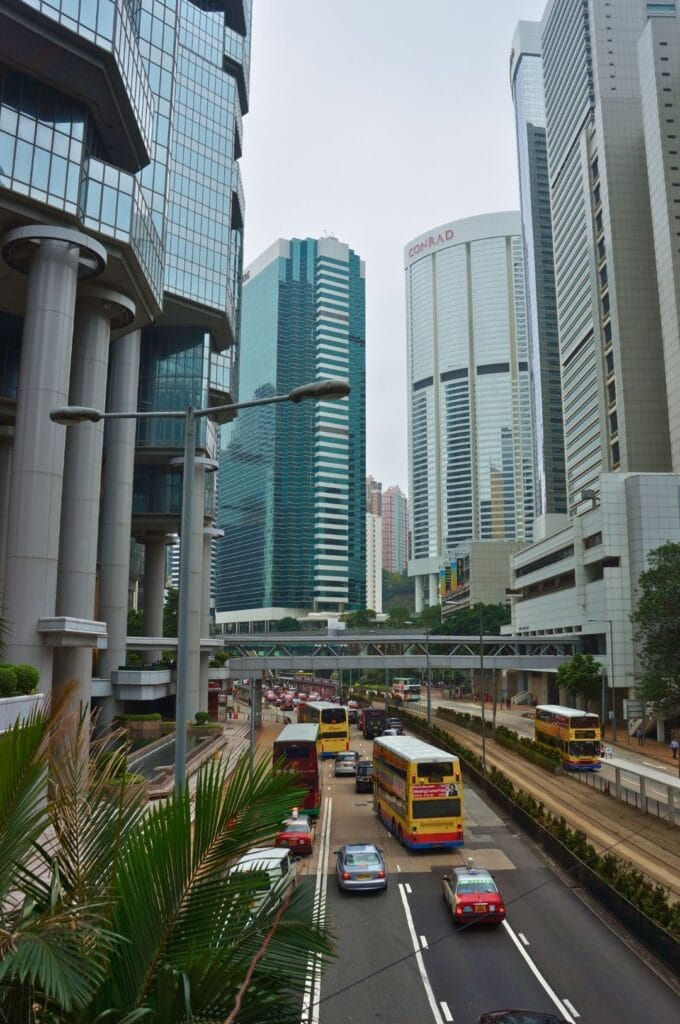
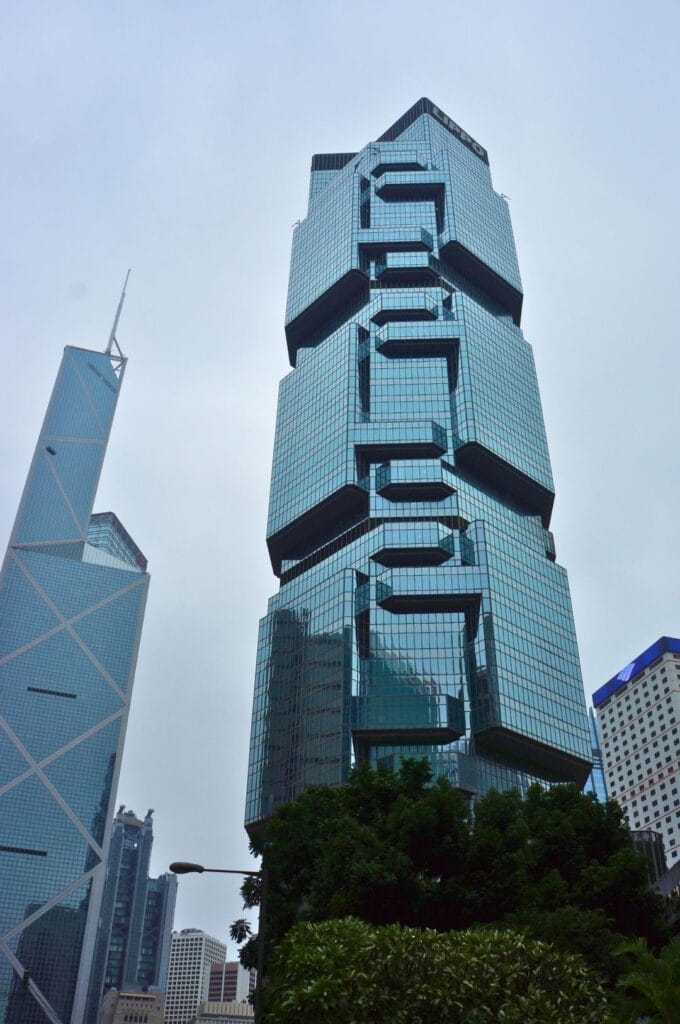
Visit Man Mo temple in Sheung Wan district
On Hong Kong Island, Sheung Wan is both Hong Kong’s Chinatown and the historic district. Located just west of Central, stroll around for a real contrast! You’ll find old shops, antiques on Cat Street, street art, an old police residence rehabilitated into a cultural and commercial center (the PMQ), etc. It’s probably Hong Kong’s most unique corner. Dare to get lost in the alleys!
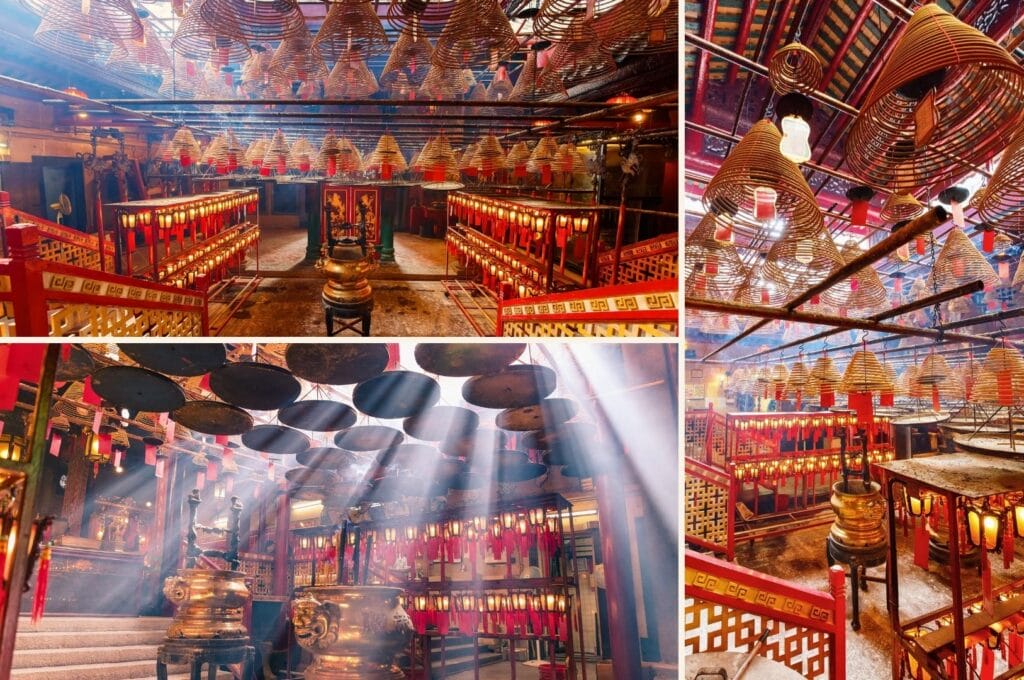
In addition, we recommend visiting Man Mo temple. Besides being a superb building dating from the mid-19th century, it’s also Hong Kong’s oldest temple. Dedicated to Man Cheong (god of literature) and Kwan Tai (god of martial arts), this Taoist temple is renowned for its almost mystical atmosphere, thanks to the incense and its remarkable architecture. Admission is free.
Ride a ding ding and discover the temples of shopping
From Sheung Wan, take the famous ding ding – the double-decker tram – to get to Causeway Bay, the largest concentration of shops in the world! If you have nothing to buy, we’d recommend at least stopping by Times Square, Hong Kong’s largest mall. For fashionistas, head to Lee Gardens or Hysan Place.

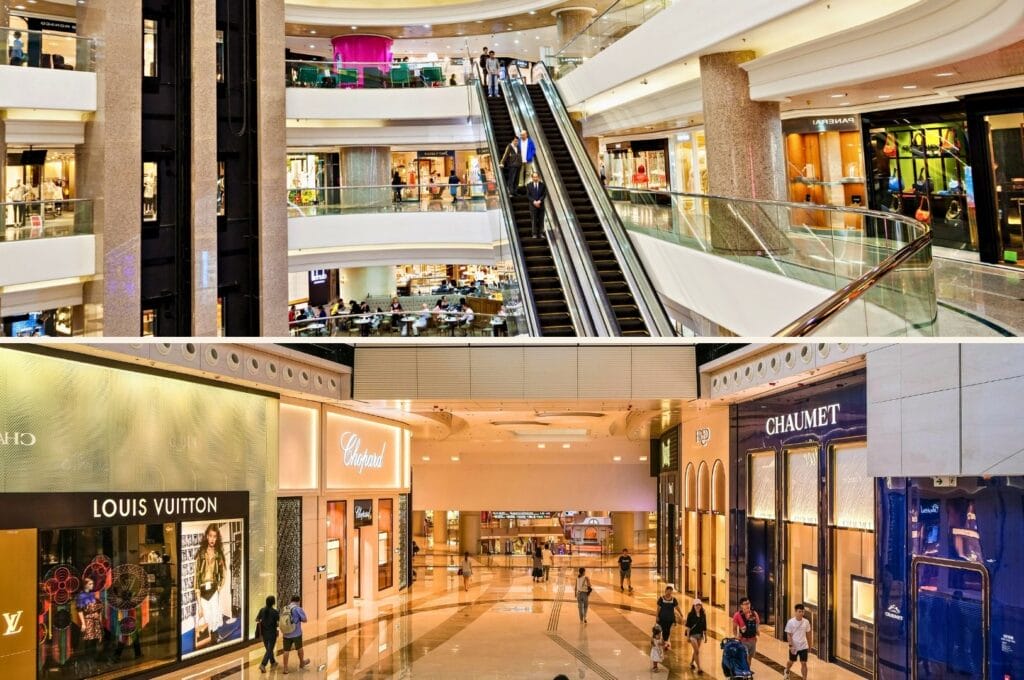
Hike the Dragon’s Back
The Dragon’s Back Trail is one of Hong Kong’s most beautiful trails! It follows the ridge connecting the peaks of southeastern Hong Kong Island, hence the dragon analogy. On the program: an easy 5 km walk with beautiful views of the coast! You’ll pass through the summit of Shek O Peak, 284 meters above sea level, with a nice viewpoint over the islands and bay.
Getting there is quite easy: take the metro or tram to Shau Kei Wan station, exit A3. 2 meters away, wait for bus 9 (departs every 15 minutes) or board the red Shek O minibus and get off at To Tei Wan stop after about 20 minutes. The hike starts just behind the bus stop.
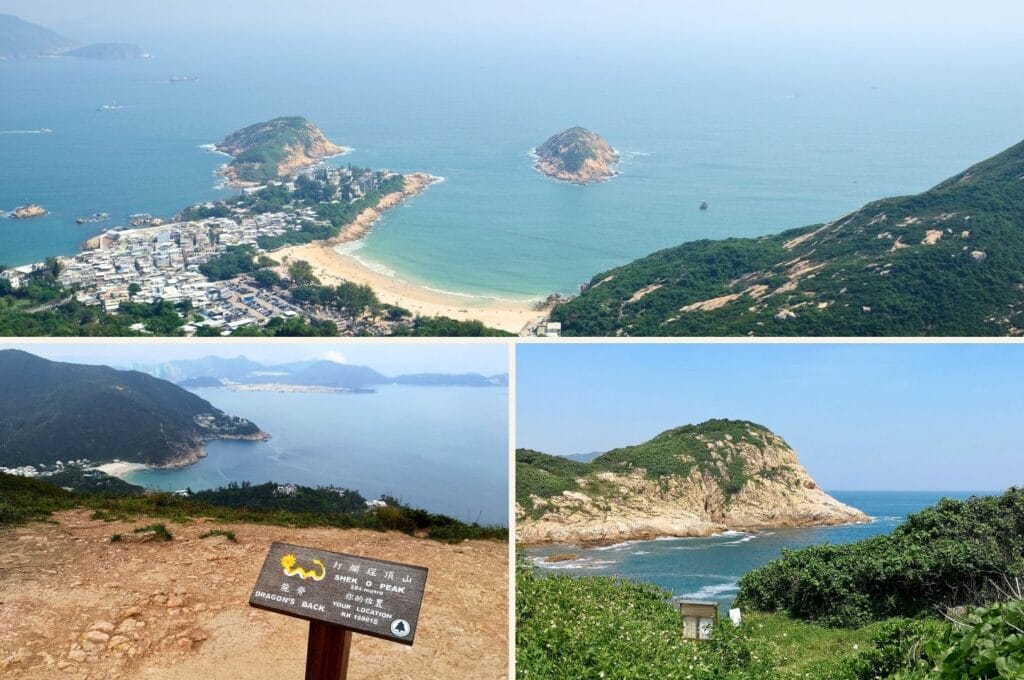
If you have some time, you can continue to Tai Long Wan village and Big Wave Bay beach, famous for its waves. This adds 3 km, almost without elevation gain. From there, you can take the red minibus to Shau Kei Wan station. Otherwise, at Tai Tam Gap (where the trail ends), bus 9 also provides the connection to the station.
To have the offline map, download it.
Climb to the top of Victoria Peak
Your Hong Kong stay wouldn’t be complete without visiting The Peak or Victoria Peak, the island’s highest point at 552 meters high. The 360° view of the skyline is simply breathtaking! Late in the day, with the golden hour and the city lighting up at sunset, the spectacle is just magical.

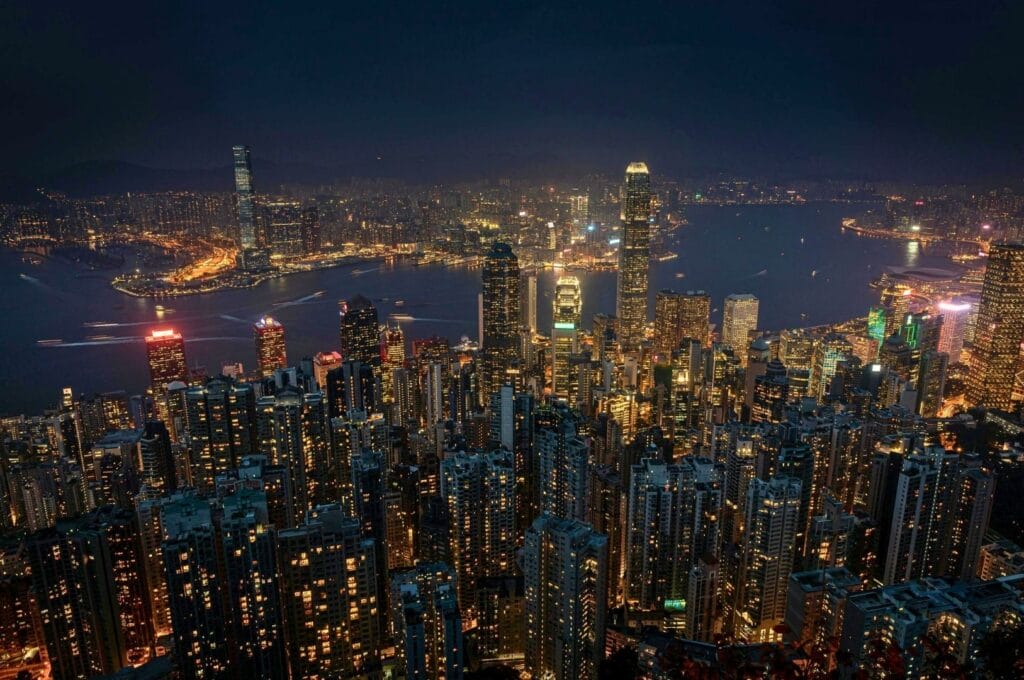
To get there, you can:
- Take the Peak Tram funicular from Central, next to Hong Kong Park, 10 10-minute walk from Central metro station. The ticket price is 136 HKD one-way (10-minute journey) or 168 HKD round-trip, including access to Sky Terrace 428, at the top of The Peak tower. Since the funicular is very popular, we recommend buying skip-the-line tickets to avoid waiting (sometimes 1 hour!). The Peak Tram operates daily between 7:30 a.m. and 11 p.m. with departures every 15-20 minutes. The tower terrace is accessible daily from 10 a.m. to 11 p.m. on weekdays and from 8 a.m. to 11 p.m. on weekends.
- Take the bus: it’ll be a bit longer than the funicular but much cheaper! From Central station, it’s bus 1 that goes directly to the summit in 15-20 minutes.
- Walk! 2 options: start from the University of Hong Kong (HKU MTR stop) and climb to the summit on the Lung Fu Shan trail, or start from the beginning of Old Peak Road, southwest of Central. These paths are marked on the map below: Lung Fu Shan is in blue and Old Peak Road is in green.
Whatever your means of transport, an easy trail goes around the peak and offers magnificent viewpoints! If you don’t want to pay to go on the tower terrace, this is a good plan ;). The Peak Circle Walk is 4 km with 140 m of positive elevation gain. Download the GPX track by clicking this link.
Day 4 on Lantau Island
It’s time to explore Lantau, Hong Kong’s largest island, resolutely different from the Kowloon Peninsula and Hong Kong Island. Here, you can breathe! Even though Disneyland park and the international airport are located on these lands, nature largely prevails over the city!
See the Big Buddha of Lantau
We had already seen the largest Buddha in China in Leshan, but here’s its more recent bronze counterpart. At 34 meters high, the Tian Tan Buddha dominates Lantau Island! Rather than explaining the meanings of this statue, we refer you to this article. After climbing more than 250 steps to the promontory, you’ll have a beautiful overview of the tropical forests and the island’s immensity.
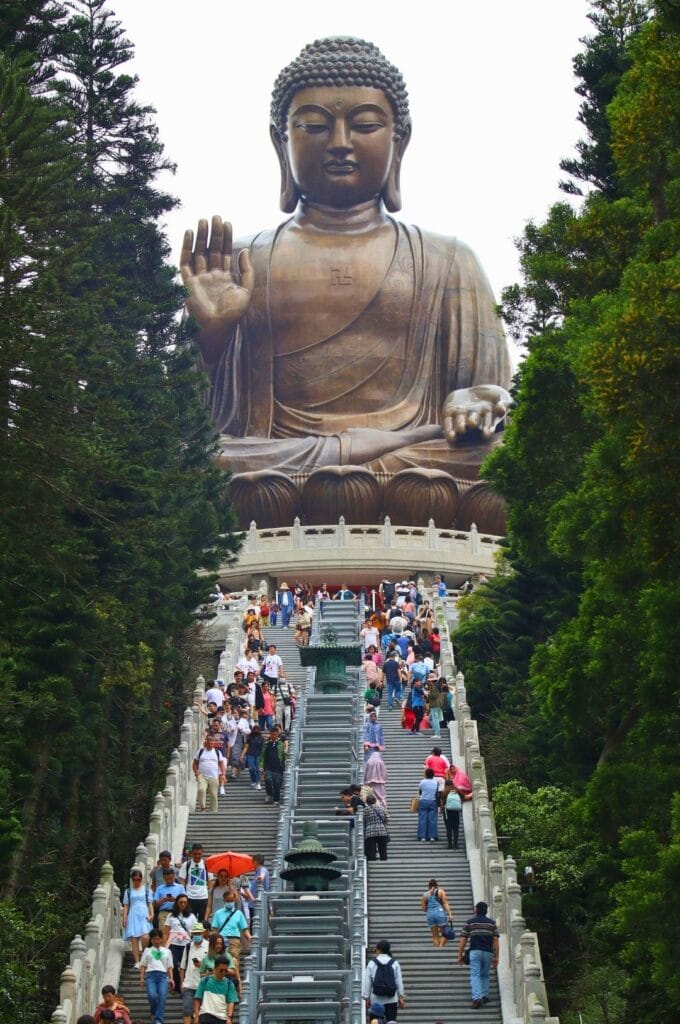

The Big Buddha is located in Ngong Ping village and the nearest metro station is Tung Chung (50 minutes from Tsim Sha Tsui). But how to get there from the MTR?
- By taking the panoramic funicular: from Tung Chung metro station, the Ngong Ping 360 funicular takes you to its foot in 25 minutes. We heard that the queues can be endless… Chinese tourists don’t particularly like walking; the funicular is their preferred option. To avoid waiting, it’s better to buy a skip-the-line ticket in advance! The funicular operates daily from 10 a.m. to 6 p.m. on weekdays and from 9 a.m. to 6:30 p.m. on weekends.
- By bus: the bus station is right next to the MTR station. It’s bus 23 you need to take to arrive at the Buddha’s foot, after 1 hour of travel.
- With a private driver: even simpler and at the same price as the funicular, the private driver takes you by car from Tung Chung station. The Buddha, Po Lin Monastery, and Tai O village will have no secrets from you! Discover all the details of this service here.
- On foot: the Tian Tan Buddha is on the route of the Lantau Trail, a 70 km trail (and 3500 m of positive elevation gain) that roughly goes around Lantau Island. Rest assured, no need to do the entire hike! To finish the walk at the Big Buddha, you’ll need to do section 3, which is 5 km with 560 m of positive elevation gain (download the GPX track). On the program: a 100% nature hike with the passage of Lantau Peak at 934 m altitude with a magnificent 360° view! The start is at the Pak Kung Au bus stop, served by buses 3M and 11 from the stop just behind Tung Chung station. The journey takes 20-25 minutes at most.
Practical information: Access to the Tian Tan Buddha is free and the site is open daily between 10 a.m. and 5:30 p.m.
Stop by Po Lin Monastery
Right next to the Buddha statue, Po Lin Monastery is worth seeing. A true nerve center of Buddhism in Hong Kong, Po Lin is a complex of several temples with traditional architecture. Don’t miss the incredible Hall of a Thousand Buddhas, all golden with its many statues. Admission is free and the monastery is open daily from 9 a.m. to 6 p.m.

Stroll through Tai O village, a stilt village
Very often, travelers head toward Tai O after visiting the Buddha. Tai O is a fishing village on stilts, nicknamed the “Venice of Hong Kong”. Forget the peninsula’s skyscrapers! Here, you’ll leap back in time, walking between colorful houses and dried fish stalls, the local specialty.
The authentic village is full of charm and it’s an opportunity to witness scenes of traditional Hong Kong life. Tai O isn’t very big – you can walk around it in less than an hour – but we bet you’ll stay longer to taste the seafood, walk along the coastline on the Fu Shan trail to the northwest, or just savor the peaceful atmosphere that reigns there.
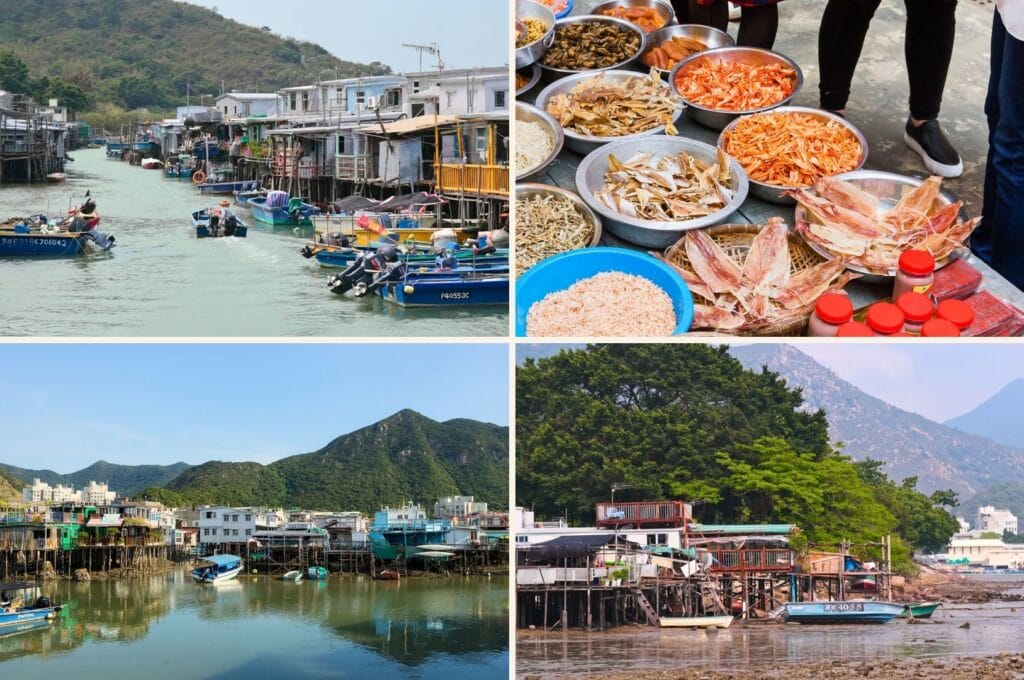
How to get to Tai O:
- From the Kowloon Peninsula: take the metro to Tung Chung station (50-minute journey).
- From Tung Chung metro station: bus 11 leaves from the bus station to Tai O, after about 1 hour of travel.
- From the Giant Buddha at Ngong Ping: bus 21 takes you directly to Tai O in 20 minutes.
- By guided tour or private driver: since Tai O is a popular stop after the Giant Buddha, you can combine the two with this excursion or by hiring a private driver.
- By boat: ferries leave from Central to Mui Wo port. From there, take bus 1 to Tai O (1-hour drive).
Watch the sunset from one of Lantau’s beaches
If you want to enjoy Lantau Island’s tranquility even more, go sip a drink on one of Lantau’s beaches! Some hotels are right on the sand, which could be a nice way to conclude your Hong Kong stay, right? Among the quietest spots, Cheung Sha is still well-preserved from tourism, as is Tong Fuk beach, also in the south of the island.
Should you buy the Go City Pass?
Like many big cities, Hong Kong has its Go City Pass, a package to visit several points of interest. But is it really a good deal? Actually, it depends on what you choose from the activities offered. It ranges from the Big Bus to the Ocean Park ticket to museums.
On one hand, the Go City Explorer pass is valid for 30 days and you choose the number of attractions from 26 options. For 3 attractions, the pass still costs 94 euros… If you’re just thinking of using it for the Peak Tram, the Big Bus, and a walking tour of Hong Kong, it’s not worth it. You’ll pay less by buying your tickets separately.
On the other hand, the Go City all-inclusive pass gives access to all activities offered and you choose the validity period, between 1 day (94 euros) and 7 days (353 euros).
In our opinion, they would be worthwhile if you stay more than 3 days and want to do several paid activities. To avoid rushing to get your money’s worth, we recommend establishing your itinerary to see which attractions interest you. If your budget is tight, no need to ask yourself: don’t get them ;). Know that you can perfectly enjoy Hong Kong without doing these paid activities.
Other activities for stays longer than 4 days
Here are other activity ideas if you’re traveling with family or staying more than 4 days in the Hong Kong metropolis!
Marvel at Disney
We don’t need to introduce Disneyland parks anymore! But if you’ve already been to one, Hong Kong’s might disappoint you a bit… Rest assured, the Disney magic is still there! It’s just that the park is smaller than the others with its 4 worlds, and the attractions lack a bit of thrills. If you don’t know what to do with your kids, this can be a good plan!
On ne présente plus les parcs Disneyland! Mais si vous en avez déjà fait un, celui de Hong Kong risque de vous décevoir un peu… Rassurez-vous, la magie de Disney est toujours là! C’est juste que le parc est plus petit que les autres avec ses 4 mondes et les attractions manquent un peu de sensations fortes. Si vous ne savez pas quoi faire avec vos têtes blondes, ce peut être un bon plan!
Practical information: Hong Kong Disneyland is located on Lantau Island, next to the Disneyland Resort MTR stop. You’ll be there in less than 50 minutes from Tsim Sha Tsui. Price-wise, it’s the same as Paris… Expect 74 euros per adult and 55 euros per child between 3 and 11 years old. Good deal: tickets are cheaper online and they’ll also save you queuing.
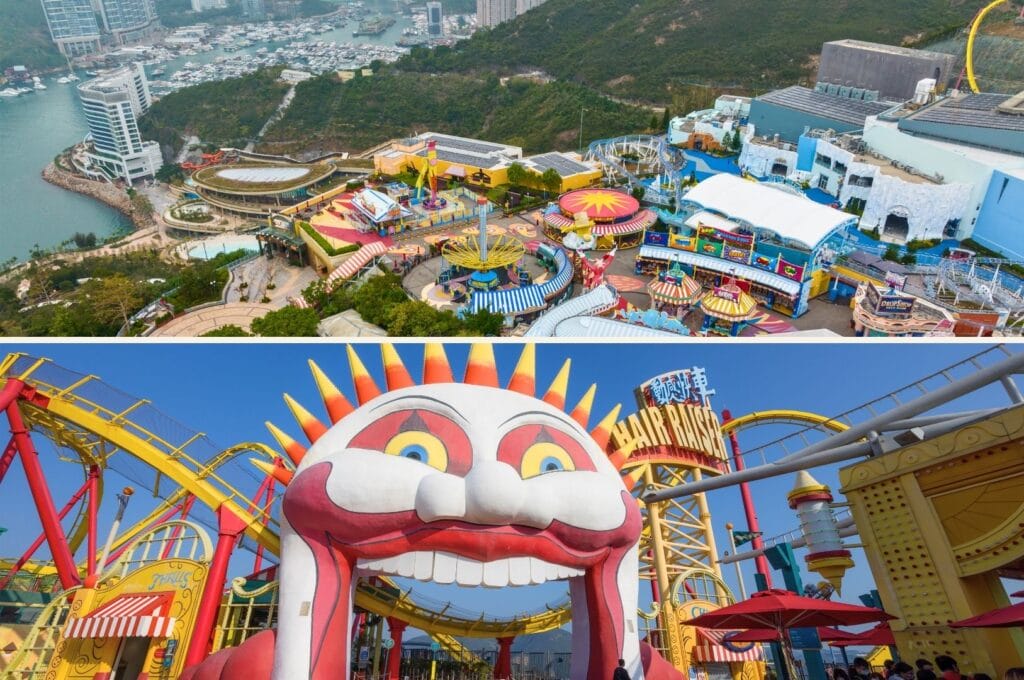
Have fun at Ocean Park
In the south of Hong Kong Island, competition with Disneyland is fierce! Ocean Park is another amusement (and animal) park with the theme of the marine world. Well, you’ll still find pandas and no fewer than 45 attractions that will delight young and old alike.
Practical information: From Central station, take the MTR and get off at Ocean Park stop (20-minute journey). The ticket costs a bit less than the Disneyland one. Expect 60 euros per adult and 30 euros per child aged 3 to 11.
Explore Cheung Chau Island or Peng Chau Island
Often, travelers focus on Kowloon, Hong Kong Island, and Lantau Island and forget the many small islands all around. This is the case with Cheung Chau and Peng Chau, 2 pieces of land where local life is in full swing, far from the crazy energy of the center. In short, we recommend them to get off the beaten track! They’re accessible by ferry from Central port on Hong Kong Island and Mui Wo port on Lantau Island.
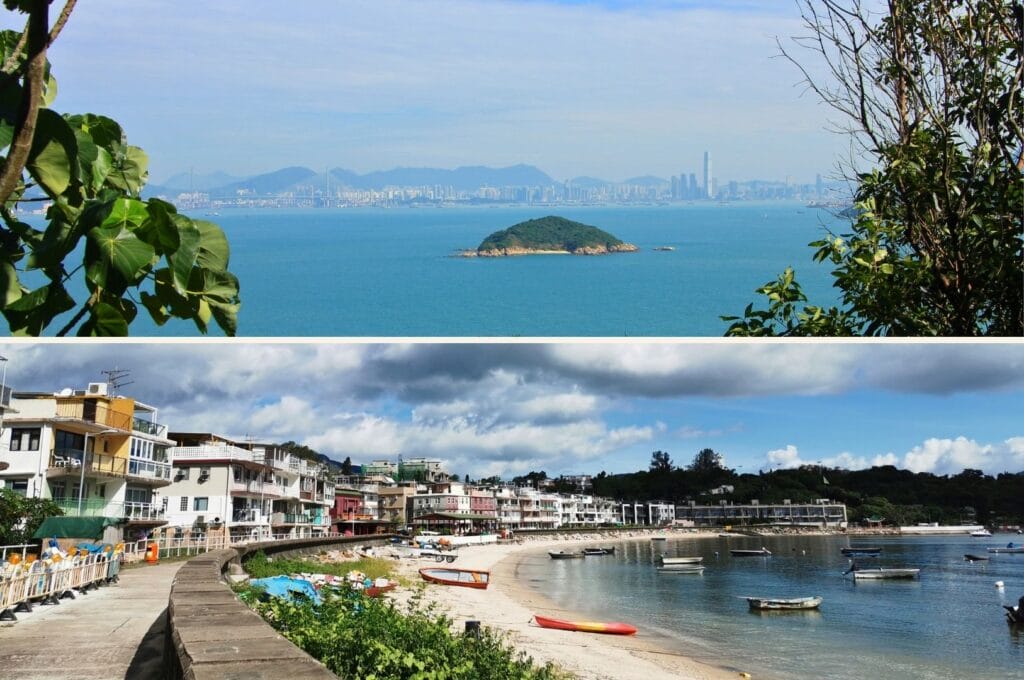
Dive deeper into street art
You’ll have noticed, in Hong Kong’s streets, street art is an institution. Each year, the HK Walls festival takes place, which highlights a neighborhood as well as the murals created for the occasion. To learn more about the festival (dates, location…), visit the official website. You’ll find maps of the neighborhoods with all the works from each edition.
Hike in Sai Kung East Country Park
We could have put this activity in the 4-day itinerary because it’s splendid! If you want to discover one of Hong Kong’s gems on foot, head to Sai Kung East Country Park, only 1 hour from Hong Kong. Here, it’s all about tropical forests, hills, bays, and deserted beaches. You’ve got it, it’s a dreamy place for hiking and there are plenty of possibilities. There’s enough to walk for days!

The most famous trail is the MacLehose, which crosses the New Territories. But hey, it’s still 100 km! You can always do section 1 (10 km and 400 m positive elevation) or section 2 (14 km and 650 m elevation) in the Sai Kung Peninsula. Otherwise, we’d recommend the trail to reach Long Ke Wan beach. The hike is 5 km one way with 270 m positive elevation and the views are breathtaking! Download the GPS track by clicking here.
Practical information: Most hiking trails start from Sai Wan Pavilion. To reach Sai Kung East Country Park, you’ll have a choice between bus or taxi. The metros don’t go to Sai Kung village, at the park’s gates. Ideally, reach the nearest metro station, Choi Hung. There, take exit C2 and take minibus 1A or bus 92, which will take you to Sai Kung in 1 hour. Then, walk to this location to take minibus NR29 to Sai Wan Pavilion stop (30-minute journey).
Get the best view of Hong Kong
Being 400 meters above the ground doesn’t scare you? Then head to the 100th floor of the ICC tower, where the Sky100 observatory is located! You’ll have a panoramic view of Hong Kong and the business district. The tower is located on the peninsula, next to Kowloon MTR station. Admission costs 160 HKD per person.
Note: The observatory is currently closed for renovations. Reopening is expected in 2026.
Attend a horse race at the Hong Kong Racecourse
Are you in Hong Kong on a Wednesday and have never seen a horse race? Then don’t miss the race, which starts at 7:30 p.m. at Happy Valley Racecourse on Hong Kong Island! Apparently, the atmosphere there is really good and the setting – a racecourse surrounded by tall buildings – makes the experience unique.
Admission is free upon presentation of your passport (otherwise it’s 10 HKD). For total immersion, we recommend this guided activity. Getting to the racecourse is very easy. By metro, get off at Causeway Bay station and take exit A. By tram, get off at Leighton Road stop or at Happy Valley terminus. Note that doors open at 5:30 p.m.
Visit Macau
Macau is a former Portuguese colony, nicknamed “Asia’s Las Vegas”! Located 65 km from Hong Kong, it also has special administrative region status. Smaller than Hong Kong, it’s Asia’s gambling capital with its many casinos! Otherwise, the old town is worth seeing with its architecture directly influenced by Portuguese colonizers. 1 day is enough to see the essentials of Macao.
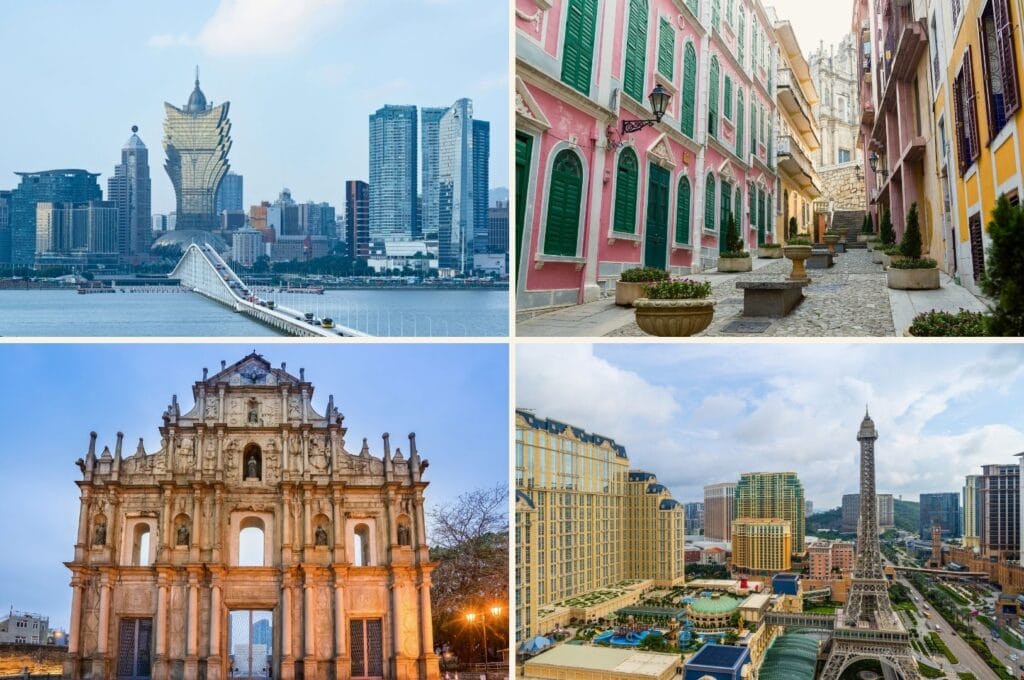
Do you need a visa to visit Hong Kong?
You don’t need a visa to visit Hong Kong. A visa is only required if you plan to stay in HK for more than 90 days :). For any information, we invite you to read the section on how to obtain a visa for China.
Note: As with the rest of the country, travel insurance is mandatory to enter the territory.
Money and backpacking budget in Hong Kong
Currency and payment methods
This special administrative region of China has its own currency, the Hong Kong dollar (HKD or $HK). The rate is quite stable, 1 euro = 8.9 Hong Kong dollars.
Once you’ve set foot on Hong Kong soil, the first thing to do is buy an Octopus card. With it, you can pay for everything during your stay: transport, shopping, restaurants, activities… This rechargeable card costs 39 Hong Kong dollars, or 4.3 euros. It’s sold almost everywhere: at the airport, at 7-Eleven, Circle K, MTR stations… The big advantage? It’s accepted absolutely everywhere, unlike your foreign card! To put it simply, cash and the Octopus card are the only payment methods for some buses and in some local restaurants.
What travel budget to plan?
We told you from the beginning of this article, traveling to Hong Kong will cost you more than traveling in China! In order, accommodation, shopping, and activities are likely to hurt the most, especially if you’ve traveled in China or Southeast Asia just before.
To give you an idea, we spent the equivalent of 400 euros for 4 full days on site, which gives a daily budget of 50 euros per person. Today, it would be about the same, expect a good 4000 HKD for 4 days for 2 people.
Let’s break down our backpacking budget:
- Accommodation: 152 euros (38%)
- Food: 216 euros (54%)
- Extras: 18.8 euros (4,7%)
- Transport: 13.2 euros (3,3%)
We didn’t do any paid activities and yet our budget remains high, fault of the accommodation but also food :). Even though we ate almost only in the markets, we treated ourselves! We give you all the tips just below to limit the bill during your trip.

How to travel cheaply in Hong Kong?
Are you a backpacker and your budget is ultra-tight? Here are the free activities worth visiting:
- Wong Tai Sin Temple and Good Wish gardens;
- Nan Lian gardens and Chi Lin nunnery;
- The markets;
- Ten Thousand Buddhas Monastery;
- Hong Kong Heritage Museum;
- Avenue of Stars and the waterfront;
- A Symphony of Lights show;
- Man Mo Temple;
- Victoria Peak on foot;
- Dragon’s Back hike;
- Giant Buddha and Po Lin monastery on foot;
- Getting lost in the different neighborhoods…
As for food, eating at the markets is very economical; prices will be unbeatable there. Regarding transport, the MTR is the cheapest solution after your feet ;). Avoid taxis and walk as much as possible. You’ll definitely spend less by staying in one corner of Hong Kong rather than visiting everything and thus taking the metro for longer distances.
What to eat during your trip?
In Hong Kong, the cuisine is very culturally rich and you can eat anything at any price! Whether you prefer eating on the street for less than 5 euros or treating yourself in a Michelin-starred restaurant, everything is possible. We even found a Swiss chalet that serves fondues in Kowloon and a raclette cheesecake! However, Hong Kong has some specialties that you can only taste here. A quick overview of the must-try dishes in this bustling metropolis!
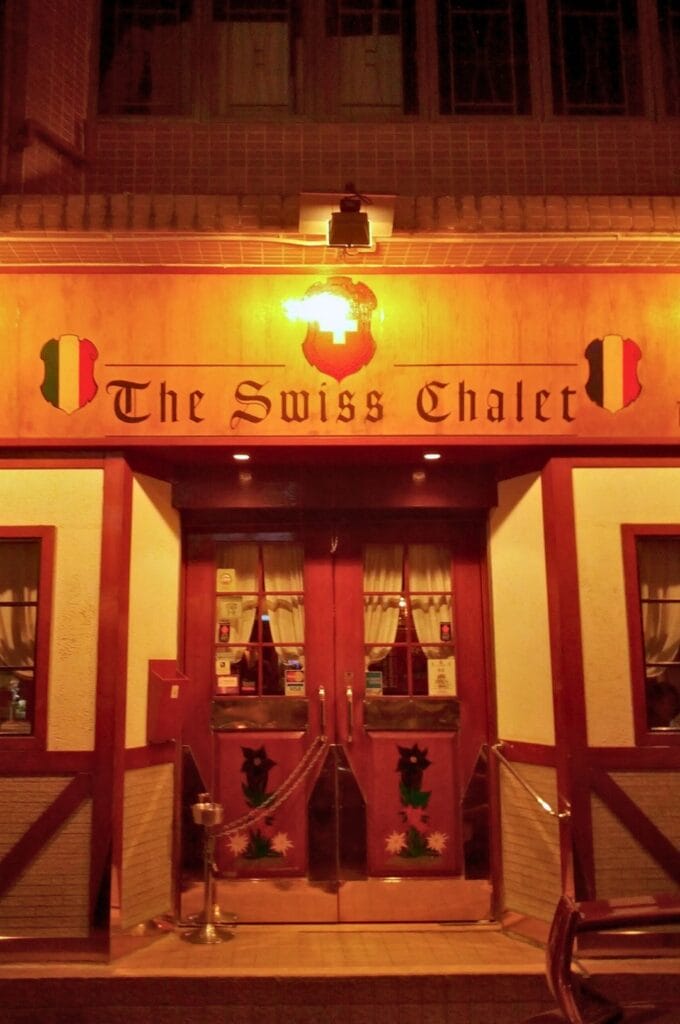

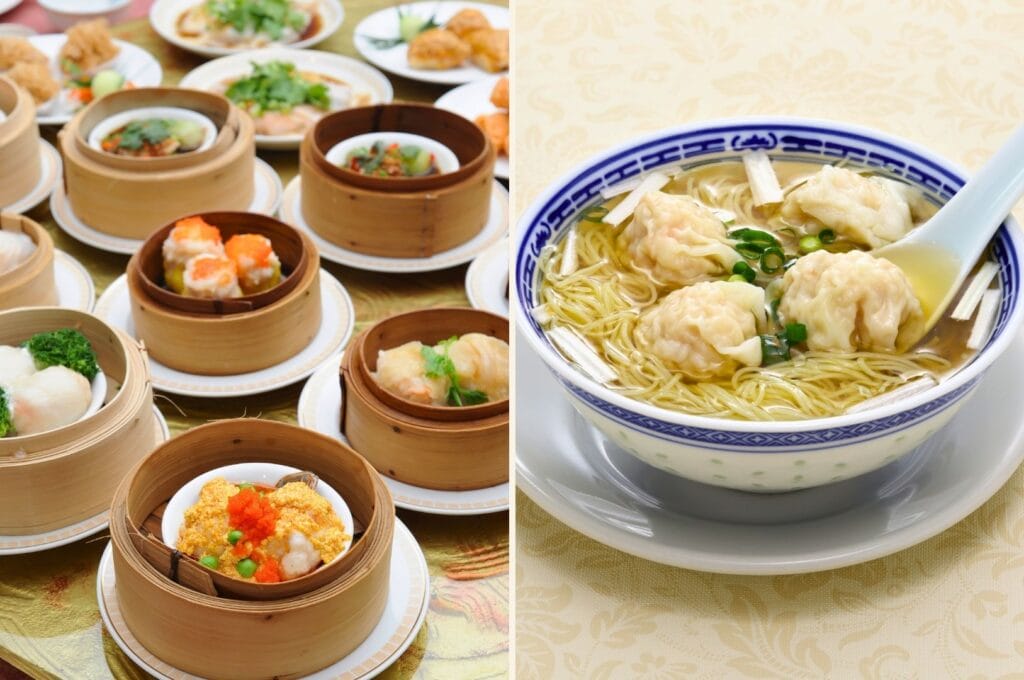
Dishes
We had already talked about dim sum in the Chinese dishes to taste. These little steamed bites have lots of different fillings (beef, shrimp, pork…). The only address to remember in Hong Kong is Tim Ho Wan. We didn’t try it because we preferred to eat at the street markets. This establishment even got 2 stars in the Michelin guide! Rest assured, prices remain affordable despite this distinction.
For fish fans, head to Lantau Island, renowned for its fresh fish and seafood! If you want to taste dried fish, go to Tai O fishing village on Lantau Island.
Finally, wonton noodles are also a classic, especially in street food! The noodles are served in an aromatic broth with wontons, shrimp dumplings.
Desserts and drinks
Will you finish your meal with a sweet touch?
Egg tarts from Tai Cheong Bakery in Central are an institution! They closely resemble pastéis de nata, the Portuguese specialty. Their composition? A crispy puff or shortcrust pastry surrounding a smooth custard.
Equally popular, pineapple buns are small sweet buns, sometimes filled with butter or other ingredients, perfect for eating on the street. Contrary to what their name suggests, there’s no pineapple in the ingredients! It’s just the appearance that gives it its name. Kam Wah Café is renowned for enjoying these treats.
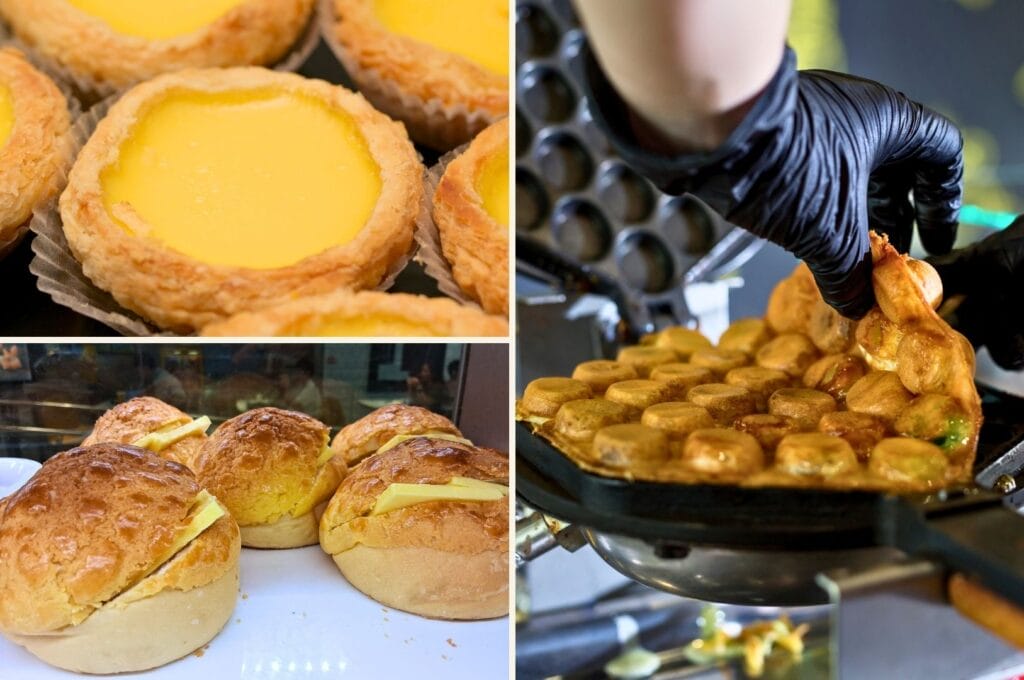
Finally, bubble waffles (or eggettes or egg waffles) have become popular in recent years, especially thanks to social media. But it’s in Hong Kong that they originated. They almost look like honeycomb cells and each “bubble” is filled with chocolate, matcha, banana… There’s even a savory version made with cheese, sesame, or pork. The most famous chain for these waffles is Mammy Pancake; you’ll find them almost everywhere in Kowloon and the north of Hong Kong Island.
To accompany dessert, opt for a Hong Kong-style milk tea, a black tea with condensed milk or not, sweetened or not. It’s the typical drink you’ll see everywhere.
WiFi, coverage and SIM card
Hong Kong is extremely well-connected. WiFi is available for free in many places: restaurants, shopping centers, parks, and metro stations. To stay connected permanently, you can buy a local SIM card or eSIM at the airport or at a 7-Eleven. Expect about 10 euros for a card with 12 GB of data, valid for 7 days.
To enter Chinese (and Hong Kong) territory, you must have travel insurance. If you don’t have one yet, feel free to check out our selection of the best travel insurance.
As you can see, there’s plenty to do in Hong Kong! Nature, shopping, history, culture… You’ll definitely find activities to your taste. As for us, we’re continuing our journey toward Thailand.
Have you done other things in Hong Kong? Share your experience in the comments ;).
Pin it


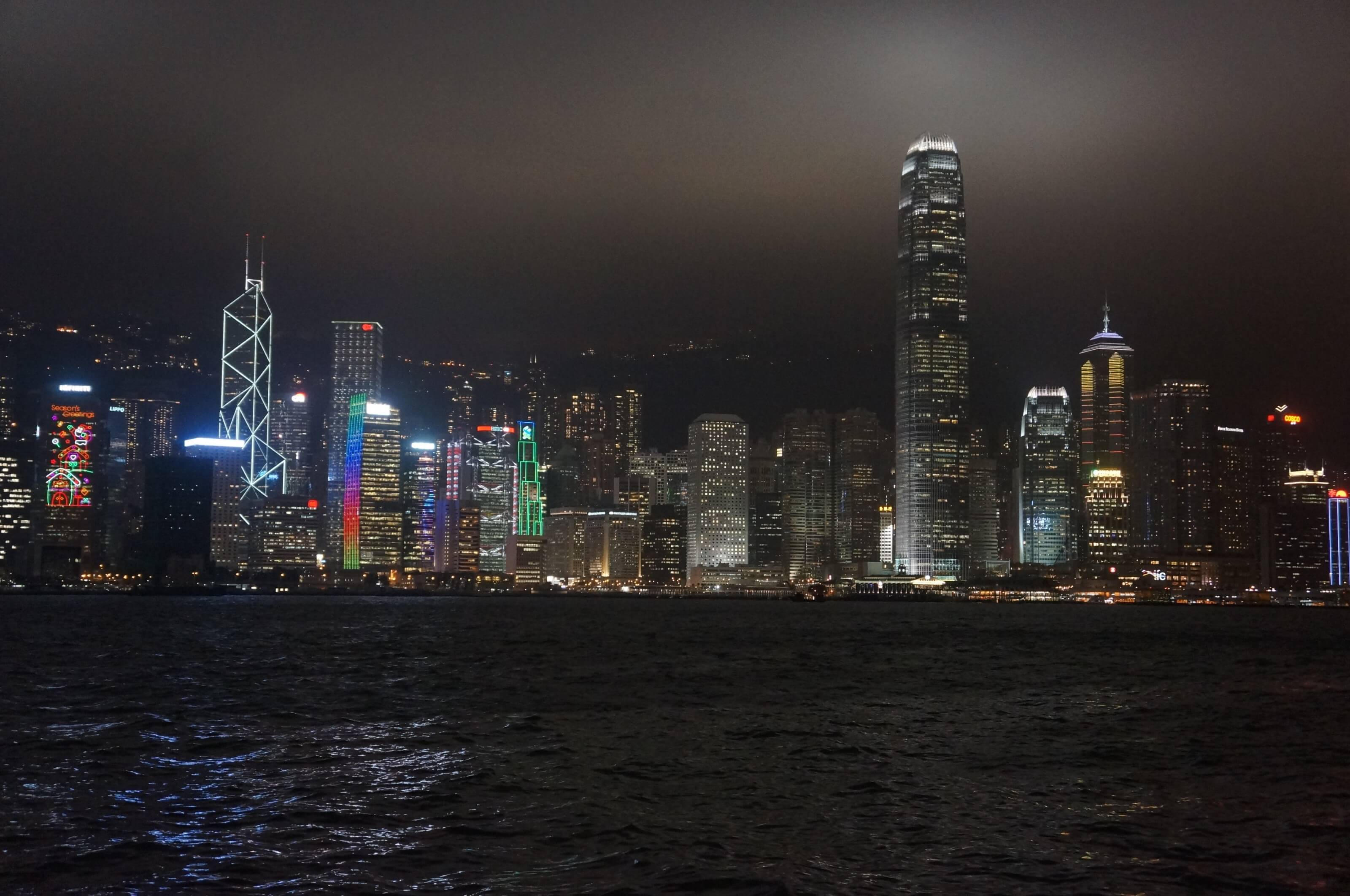



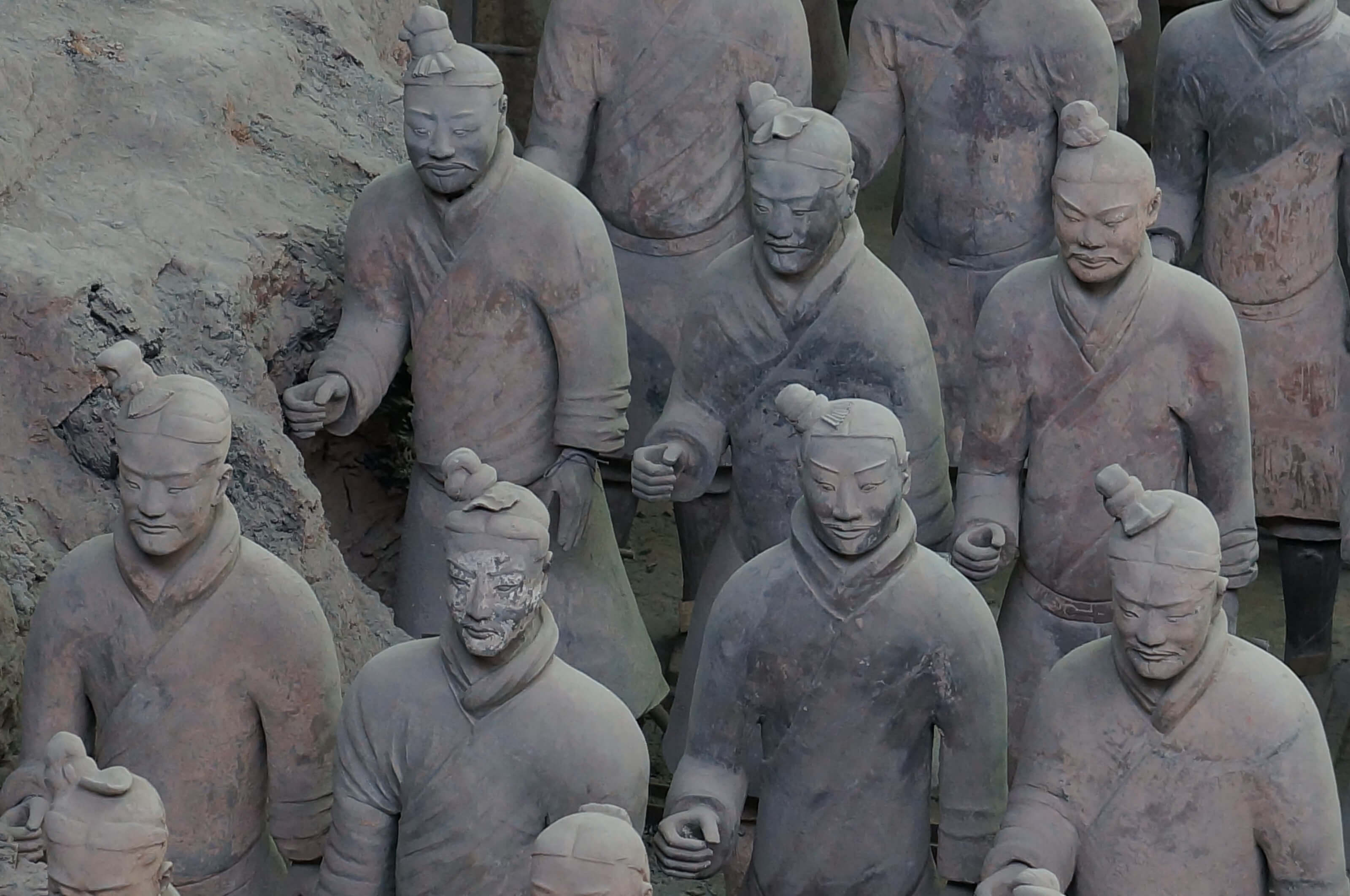
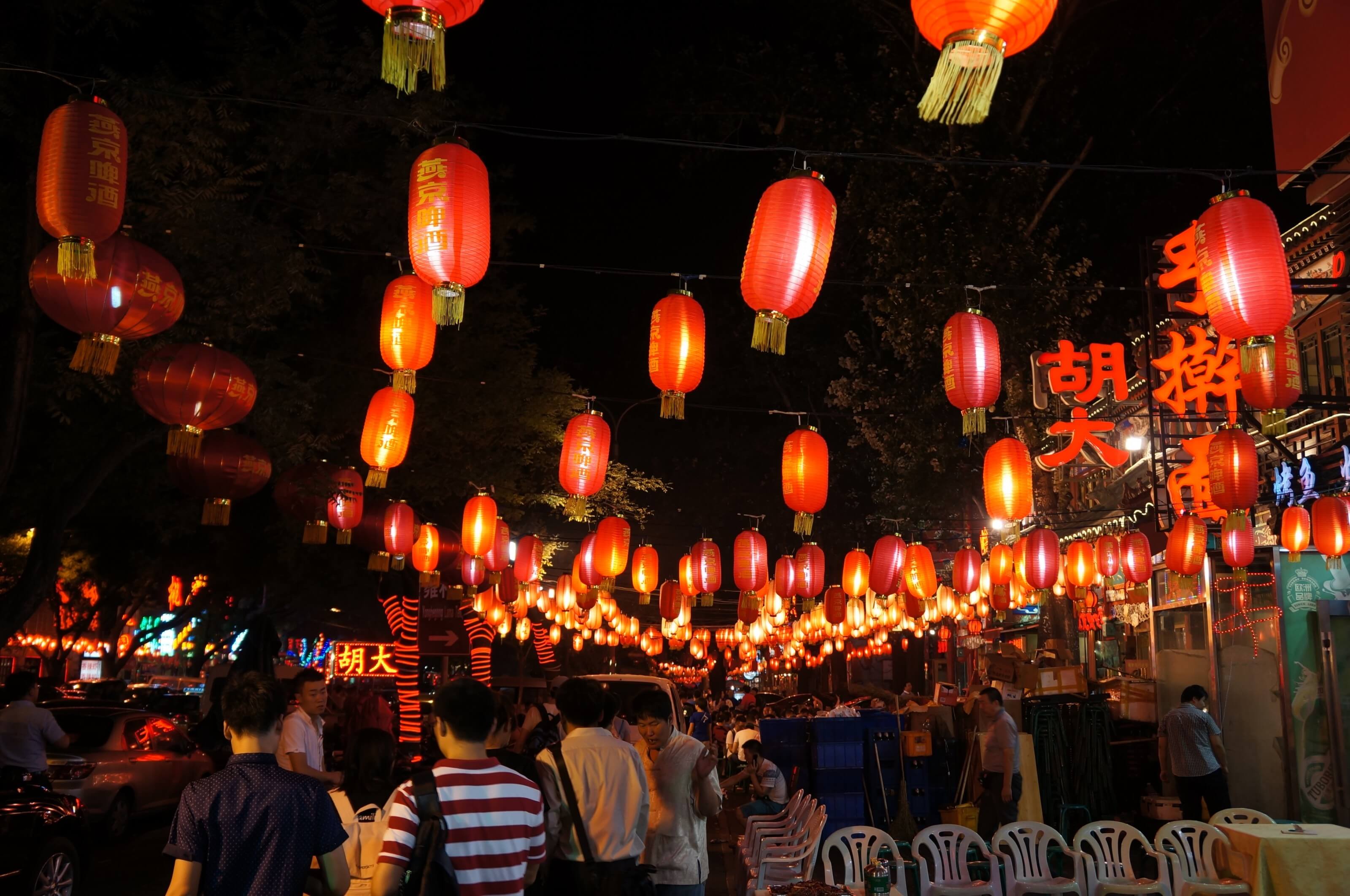
Join the discussion